https://www.blackgate.com/
Cover Reveal: Space Ships! Ray Guns! Martian Octopods!: Interviews with Science Fiction Legends, edited by Richard Wolinsky
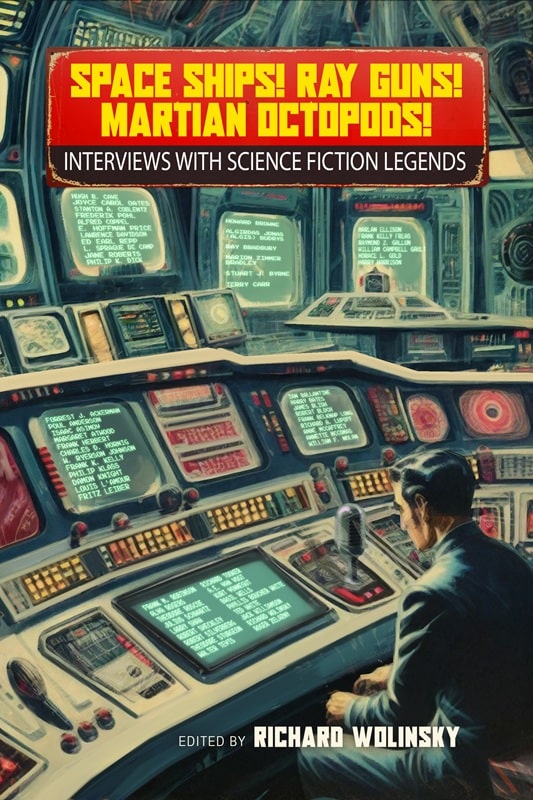 Space Ships! Ray Guns! Martian Octopods!: Interviews with Science Fiction Legends (Tachyon Publications, September 2, 2025). Cover by Yoshi Vu
Space Ships! Ray Guns! Martian Octopods!: Interviews with Science Fiction Legends (Tachyon Publications, September 2, 2025). Cover by Yoshi Vu
At Black Gate, we’re all about science fiction legends. Specifically, science fiction legends who appeared in paperback in spinner racks in the 70s and 80s. Or pulp magazines. Or wrote adventures at the dawn of the role playing industry. You know what, forget all that. We’re not picky.
What makes a true science fiction legend? This is the sort of thing that’s hotly debated on social media, and at science fiction conventions, and in lengthy blog posts titled “Towards a New Science Fiction Canon, Because Yours is Old and Stupid.” But recently, public opinion has shifted. To be a science fiction legend, the most important criteria is that your name looks good in green font on a 50s CRT monitor, preferably in a cool underground bunker. Exactly like the cover of Space Ships! Ray Guns! Martian Octopods!: Interviews with Science Fiction Legends, the upcoming book from Richard Wolinsky and Tachyon Publications.
I’ve spent long hours staring at this cover (by the marvelously talented Yoshi Vu), and the more I do, the more I’m convinced I’m right. Just look at those names. Look at how cool they are! Roger Zelazny, Theodore Sturgeon, Robert Sheckley, Jack Williamson, Fritz Leiber, Damon Knight, Poul Anderson, Isaac Asimov, Anne McCaffrey, William F. Nolan, Terry Carr, Frederik Pohl. Right now you’re shaking your head, but you know I’m right.
Those glowing green names don’t just constitute a comprehensive list of true science legends. Coincidentally, they also happen to be included in this fabulous book of interviews. Don’t take my word for it; here’s the press release to show how right I am.
In this collection of candid interviews, more than fifty legendary authors swap fascinating — and sometimes controversial — anecdotes about the Golden Age of science Fiction (1920–1960). With such guests as Ray Bradbury, Robert Bloch, Harlan Ellison, Philip K. Dick, Isaac Asimov, Margaret Atwood, Fritz Leiber, Frank Herbert, and many more, here are the wild personalities, sparks of contention, and vivid imaginations that made science fiction thrive.
Today, depictions of aliens, rocket ships, and awe-inspiring, futuristic space operas are everywhere. Why is there so much science fiction, and where did it come from? Radio producer and author Richard Wolinsky (Probabilites) has found answers in the Golden Age of science fiction.
Wolinsky has interviewed a veritable who’s who of famous (and infamous) science fiction publishers, pulp magazines, editors, cover artists, and fans. The interviews themselves, which aired on the public radio show, Probabilities, span more than twenty years, from just before the release of Star Wars through the dawn of Y2K. The result, Space Ships! Ray Guns! Martian Octopods!, is ultimately a love letter to fandom.
See? I told you.
I’m not familiar with Richard Wolinsky, but it’s clear that I should be. He cohosted Probabilities, a half-hour public radio program devoted to science fiction, mystery, and mainstream fiction, which aired in San Francisco for nearly twenty years, from 1977 – 1995. After he took the program solo in 2002 he renamed it Bookwaves, and that incarnation is still running.
Space Ships! Ray Guns! Martian Octopods!: Interviews with Science Fiction Legends belongs on every serious science fiction bookshelf. It definitely belongs on mine, anyway.
It will be released from Tachyon Publications on September 2, 2025. It is 256 pages, priced at $18.95 in paperback and $11.00 in digital formats. Get more details and order copies directly from the publisher here.
Goth Chick News: Time Stands Still in Pause: John Carpenter’s Latest Sci-Fi Horror Comic
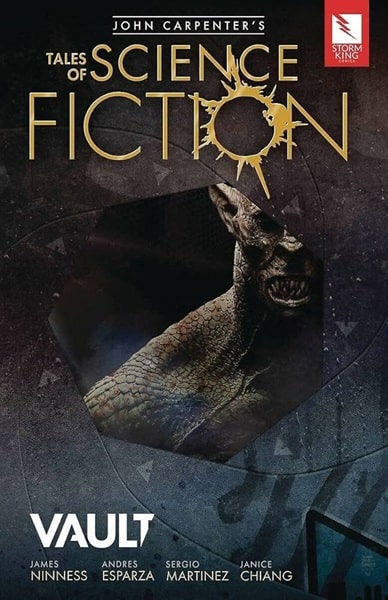
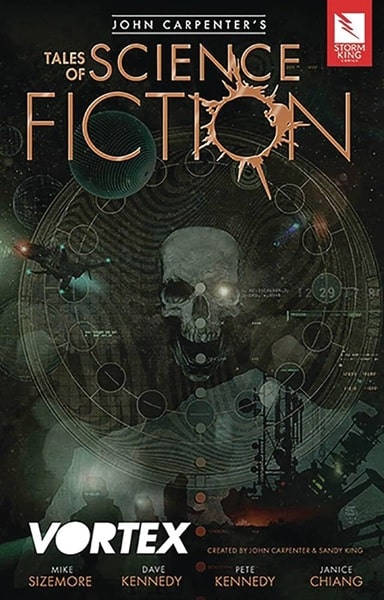

John Carpenter’s Tales of Science Fiction: Vault (June 2018), Vortex
(October 2018), and issue #1 of Pause (February 26, 2025
Storm King Comics was founded in 2012 by legendary filmmaker John Carpenter and his wife of thirty-five years, producer Sandy King. Together, they are known for delivering stories of horror, science fiction, and the supernatural, with series like John Carpenter’s Tales of Science Fiction and John Carpenter’s Tales for a HalloweeNight. Combining Carpenter’s cinematic style with the visual storytelling of comics, Storm King Comics offers fans immersive experiences that have cemented its reputation in the comic book industry.
I was first introduced to Storm King Comics by the grand dame herself, Sandy King, when I met her in 2016 at C2E2. Since then, I have collected all the issues from Tales for a HalloweeNight as well as Asylum which was my first exposure to the great stories that come out of Storm King. And though I am not a sci-fi girl strictly speaking, I love a good crossover, which this week’s launch seems to be.
For a bit of background, John Carpenter’s Tales of Science Fiction launched in 2018 with its inaugural story Vault, telling the tale of a moon-bound crew who discover an alien vessel with English markings. Since that time there have been eleven total installments and this week the series returns with installment twelve, entitled Pause.
Here’s what you have to look forward to…
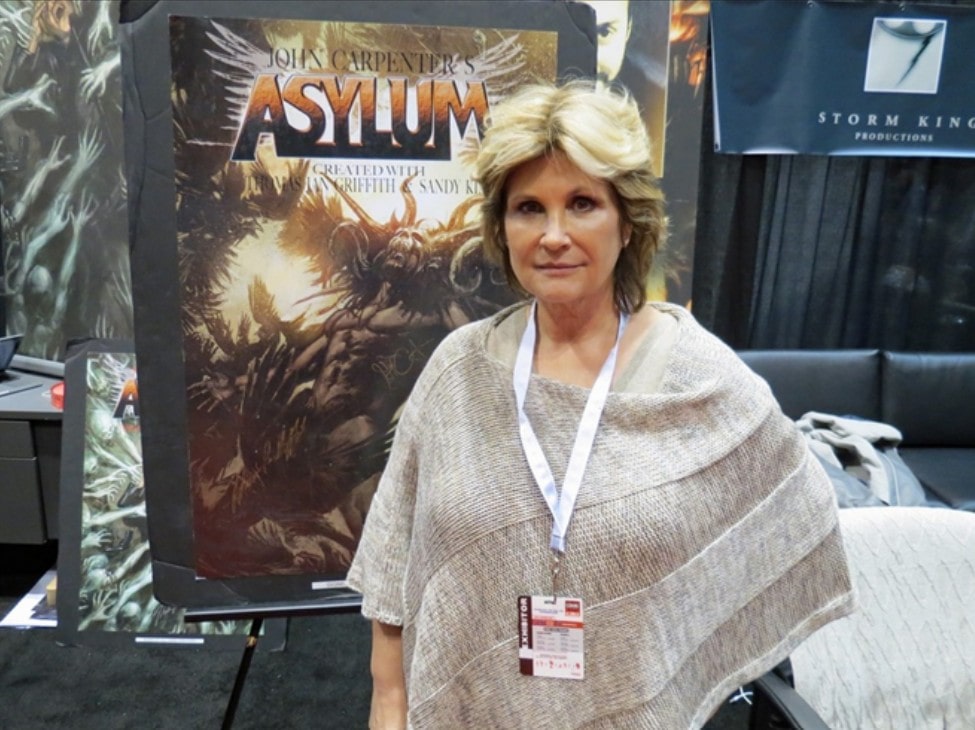 When I met Sandy in 2016
When I met Sandy in 2016
Picture this: you’re the only one not frozen in a world where time has stopped. You could lounge in a luxury Manhattan penthouse while its owner stands motionless nearby. You could feast on gourmet meals, perfectly hot and untouched, at high-end restaurants.
But what if you could bring others back to life with just a touch? Would you break the silence for companionship — or keep this frozen paradise all to yourself? The possibilities seem endless, but in a world like this, making the wrong move could unpause more than you bargained for…
Check out the trailer set to “Beyond the Gallows” from Carpenter’s latest album, Lost Themes IV: Noir.
Pause is written by Matthew K. Manning (Batman/Teenage Mutant Ninja Turtles Adventures), illustrated by Conor Boyle (Judge Dredd), and lettered by Janice Chiang.
Issue #1 of the six-issue limited series is available today, with new issues arriving monthly through August.
New Edge Sword & Sorcery Magazine – New Jirel of Joiry!
In 2023, New Edge Sword and Sorcery Magazine (NESS) emerged, and it continues to deliver outstanding magazines, renewing past classics while showcasing contemporary and veteran authors. Notably, issues 1 and 4 include Elric tales by Michael Moorcock. Black Gate featured the crowdfunding and reviewed the initial volumes, and published an interview with editor Oliver Brackenbury (links).
A new crowdfunding campaign to bring issues 5-7 to life is live on Backerkit through March 15th. NESS continues to bring us Jirel of Joiry stories! We’ll highlight Jirel of Joiry here but the magazine offers much more.
Read this to learn the trajectory of Jirel of Joiry and NESS! Jirel is alive and well!
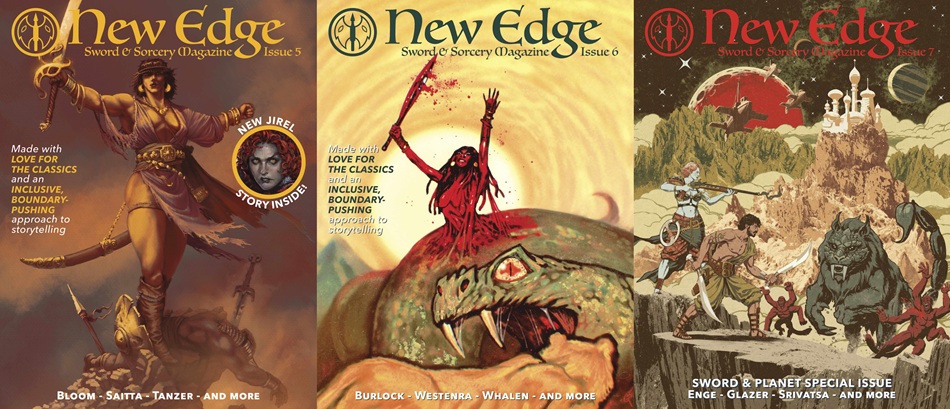 Press Release – NEW EDGE SWORD & SORCERY Backerkit crowdfunding for Issues 5-7:
Press Release – NEW EDGE SWORD & SORCERY Backerkit crowdfunding for Issues 5-7:
Building on their success in 2024, a Backerkit campaign has been launched for new issues.
TORONTO, Ontario, February 13th — Begun in Fall 2022 with issue #0, short story & non-fiction magazine New Edge Sword & Sorcery is running a crowdfunding campaign on Backerkit to produce issues #5, 6, and 7 in accessible digital, classic softcover, and luxurious hardcover (w/endpage art and a bookmark ribbon!) formats. These will be released in November of 2025.
Backing this campaign is a way to be a part of genre history: JIREL OF JOIRY will be returning with her second new story since the originals in Weird Tales! Jirel was the first Sword & Sorcery heroine, created by legendary Weird Tales regular, C.L. Moore. Like Alice in Wonderland with a big f***ing sword, Jirel had compelling adventures in bizarre dream-logic realms, balancing a rich emotional life with terrifying struggles against dark forces! Predating Red Sonja, she & Moore were a direct influence on Robert E. Howard’s writing, as well as so many who came after.
Alas, Moore only wrote a handful of Jirel tales — which are still collected, published, and read to this day. So it’s a good thing that when backers of the campaign helped it hit 100% funding in just four days, they helped make sure a new story will be published! Authorized by the estate of C.L. Moore, “Jirel Meets Death” has been written by the magnificent MOLLY TANZER (editor of Swords v. Cthulhu, author of Creatures of Charm and Hunger, and so much more).
Expanding to three issues a year also allows for the first ever special issue! NESS #7 is dedicated to S&S’ older, science-fantasy cousin Sword & Planet – featuring new S&P tales and non-fiction. Twenty-six other authors are spread across the three new issues this campaign is funding, including names like Alec “Black Beth” Worley, Premee Mohamed, and Dariel R.A. Quiogue.E
very story and non-fiction piece in the issues will be paired with two original B&W illustrations as soon as the crowdfund meets its first stretch goal – Double Art. The goal after that is a fund to cover shipping discounts for backers outside the United States, and from there every stretch goal is a pay raise for contributors. These goals make clear the magazine’s values of paying creators as much as they can, and making NESS financially accessible.
The magazine’s editor, Oliver Brackenbury, promises the magazine is “Made with love for the classics and an inclusive, boundary-pushing approach to storytelling”, delivering high quality writing and art in a wide variety of styles. Sword & Sorcery can be many things and still be Sword & Sorcery…or Sword & Planet!
Readers should race to back the magazine’s new issues before the campaign ends on March 15th, so they can benefit from crowdfund exclusives like bonus stories, discounted back issues, and cover art postcards. They can even win free, unique softcover issues annotated with behind-the-scenes info by chatting about S&S in the crowdfund’s community tab!
With the NESS pastiche continuing the heroine’s saga, here are the Jirel stories- “Black God’s Kiss” (C.L. Moore October 1934)
- “Black God’s Shadow” (C.L. Moore December 1934)
- “Jirel Meets Magic” (C.L. Moore July 1935)
- “The Dark Land” (C.L. Moore January 1936)
- “Quest of the Starstone” (C.L. Moore with Henry Kuttner November 1937)
- “Hellsgarde” (C.L. Moore April 1939)
- “Jirel and the Mirror of Truth” (Molly Tanzer 2024)
- “Jirel Meets Death” (Molly Tanzer 2025)
Ryan Harvey authored two Black Gate posts in 2007, one covering the author’s life and contributions in detail (Jirel ofJoiry: The Mother of Us All) and another reviewing Black God’s Kiss, Planet Stories‘s collection of all of C.L. Moore’s Jirel stories (including a collaboration with husband Henry Kuttner).
The red-haired, yellow-eyed, and lioness-fierce sword-wielding Jirel has an unassailable place in contemporary popular culture, along with her genre cousins, the laser-gun wielding heroine and the wooden-stake-armed heroine. Fantasy, science fiction, and horror no longer have “Males Only” signs over their doors, either for their warriors or writers. So many female authors and protagonists thrive in speculative fiction today that it seems hard to imagine a time when the opposite was the case. It feels impossible to visualize fantasy before Catherine Lucille Moore broke down the gender barriers (even if she did partially disguise her sex behind her first initials, C. L.) and brought with her Jirel. Beautiful, fierce, loyal, defiant, passionate Jirel did more than raise her sword against sorcery. She slashed through the confining walls around speculative fiction and let it reach toward the horizons in a way it never could have before her advent. That achievement alone assures Jirel and her creator a place in the firmament of the stars of fantasy literature.
— Ryan Harvey, Jirel ofJoiry: The Mother of Us All
 Saprophial interior art, NESS #3, Jirel
Author, Artist, and RPG!
Saprophial interior art, NESS #3, Jirel
Author, Artist, and RPG!
If you’re interested in learning more about Molly Tanzer and her approach to writing Jirel, check out the article Old Sorcery, New Edge: Q&A with Molly Tanzer (by Alec Worley, Feb 2024) and the Return of Jirel Interview hosted by Oliver Brackenbury, editor of NESS (2024).
NESS Magazine is always saturated with interior art. Artist Saprophial illustrated four pieces “Jirel and the Mirror of Truth”. The artist was a perfect choice since she also created the art for the 2022 Black God’s Kiss RPG Aventure and Game (check out Blazing Worlds website for more info.)
Back New Edge S&S Issues 5-7 Now! (link)
S.E. Lindberg is a Managing Editor at Black Gate, regularly reviewing books and interviewing authors on the topic of “Beauty & Art in Weird-Fantasy Fiction.” He is also the lead moderator of the Goodreads Sword & Sorcery Group and an intern for Tales from the Magician’s Skull magazine. As for crafting stories, he has contributed eight entries across Perseid Press’s Heroes in Hell and Heroika series, and has an entry in Weirdbook Annual #3: Zombies. He independently publishes novels under the banner Dyscrasia Fiction; short stories of Dyscrasia Fiction have appeared in Whetstone, Swords & Sorcery online magazine, Rogues In the House Podcast’s A Book of Blades Vol I and Vol II, DMR’s Terra Incognita, and the 9th issue of Tales From the Magician’s Skull.
Wizard Battles and Martial Arts: Legend of the Condor Heroes: The Gallants

Good afterevenmorn!
So, my various social media algorithms were working overtime the past couple of months, bombarding me with clips and training videos for the Chinese movie Legends of the Condor Heroes: The Gallants. And, of course, my interest was more than a little piqued. When I heard that the movie was getting an international release, I got more than a little excited.
Given how much I adore Chinese dramas, and kung fu movies, and the fact that I train kung fu and Chinese kickboxing (called San Da, or less frequently San Shou), there was no way in hell that I would not be going out to see this film.
I went in pretty much blind, with only a trailer (which gave nearly nothing away), and the training videos. So it had virtually no idea what it was all about. This will matter quite a bit, as we will see.
The trailer I saw
What I learnt after the fact is that this film is loosely based on the first (射鵰英雄傳 (The Legend of the Condor Heroes)) of a trilogy of books by Chinese author 金庸 (Jin Yong), which I have not read (but would love to get my hands on a translation of). The novels are technically Wixia, a Chinese historical fantasy, which typically follow an unattached warrior who follows a chivalric code (俠 (xia)). Emphasis on fantasy in this case. More on that later.
Now, I am quite familiar with the male lead Xiao Zhan (肖战), who has been in a number of dramas I’ve watched, but is probably most famous for his role in The Untamed here in the Western Hemisphere. He’s a very talented actor, and I’ve enjoyed most everything I’ve seen him in (and even the ones that were so-so, he was the bright spot for). And I’m so pleased that there was a foreign film that I didn’t have to find a niche theatre for. I was, and am, very happy to encourage more of that.
The last Chinese film I saw in theatres was Crouching Tiger, Hidden Dragon. So… quite a while ago. I remember it absolutely blowing me a way (and wrecking me emotionally), so I was really eager to see this. With that in mind, off I trundled with a couple of my martial arts students on Sunday to watch the movie.
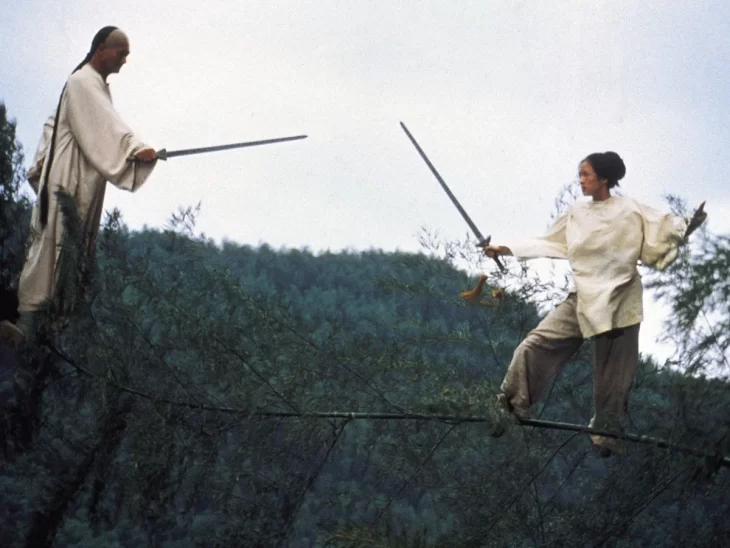 There are three movies I will rewatch any time I need a good cry. This is one of them.
There are three movies I will rewatch any time I need a good cry. This is one of them.
The movie centres on one Guo Jing (郭靖), a Han Chinese man from the Song Dynasty raised in Mongolia by the Khan who took him and his mother in following the strife between the Jin and Song empires (the Jin rise to power shattered the Song Dynasty, and they moved south to become the Southern Song Empire), and the tension between his two identities — a Han Chinese man from the Southern Song Empire and a man raised as a Mongol, by the Khan, and sworn brother to Mongols.
And it was great! A whole lot of fun; but with some caveats.
The first is that, as this was based on a novel, there is a lot of information packed into a relatively short amount of time (just over 2 hours), and if you’re not paying attention, you miss an awful lot. For those of us unfamiliar with the source material, it did lessen the emotional impact of certain scenes. It might be just my 40 episode drama-watching brain, but this probably could have been a couple of movies.
An awful lot is glossed over rather quickly in what feels like a “Previously On” moment. I was left with the feeling that there was a prequel movie that I have not seen. I haven’t done any research on whether that was the case as of the writing of this. When we finally get into the meat of the movie, Guo Jing has separated from the woman he loves, whom he travelled all over the Middle Lands and trained with, and has already mastered the techniques from a much-sought-after scroll, whom this young woman (Huang Rong (黃蓉)) apparently has possession of. Following so far?
 Our heroes Huang Rong and Guo Jing
Our heroes Huang Rong and Guo Jing
Separated, Huang Rong is pursued by three of the five masters — a martial art specialists from three of the five styles of martial arts (kung fu… sort of) in the Middle Lands. The lead, Venom West, desperately wants the scroll she carries. He was, apparently, preciously defeated by Guo Jing in an encounter we only get flashbacks of (rather disappointingly).
I’m not going to give too much away, but eventually the lovers reunite, and simultaneously save both the Khan and the Southern Song Empire; the Khan from Venom West, who has gone mad, and the Southern Song from the Mongols, who were just themselves saved.
The story itself was very fun, with some impressive action sequences, but I find myself a little disappointed that they weren’t more grounded. Remember when I mentioned that the emphasis was on fantasy? Well, all the fighting in this was basically magic battles between wizards. There was actually very little proper fighting involved. Given the training videos I saw, I was expecting a little more proper combat.
One of several videos that promised something that wasn’t delivered.
Crouching Tiger, Hidden Dragon leant into the fantasy, what with the flying through the air and landing on bamboo as if their bones were hollow/they could actually levitate. But the fighting in that was actual fighting; highly choreographed, but fighting all the same. With that as my only reference for Chinese movies, and with the training videos, I do feel a little cheated. Particularly since in several of the training videos, I could recognise the styles employed.
There was no real hand-to-hand combat in the film.
Now, it’s entirely possible that the training shorts I saw were actually for a completely different project. I do know that many of these actors are incredibly busy, working or three or more projects a year. So it’s entirely possible that all the videos were mislabelled and were for something else entirely.
The movie also ends in what feels like the middle of the story. Hardly surprising since it’s the first book in a trilogy. The sort-of middle-of-the-story vignette that this film presents is not unlike My Neighbour Totoro. Both movies left me with an “this is unfinished” feeling.
 The Khan’s daughter and a love rival. I loved her character a lot.
The Khan’s daughter and a love rival. I loved her character a lot.
Despite the slight disappointment of all the fights being wizard battles, and the unusual feeling of being shown but a snippet of a story, however, the movie was a whole lot of fun. I loved hearing both Mandarin and Mongolian. I loved how the Mongols weren’t made the villains (I initially thought they were, and it would have been easy to have made them thus — kind of like Russians for 80s Hollywood movies). And I adored having something other than the increasingly formulaic and mindless films we’ve been fed of late to spend a Sunday afternoon watching.
I really do wish more foreign films would get wide releases like this. We could use the fresh perspectives and fascinating stories other cultures bring. I had a lot of fun with this one. If you are going to see it, you must pay close attention, but it was certainly worth it. If there are sequels that make it out our way, I’ll definitely be watching. But first, I need to get my hands on English versions of these books!
When S.M. Carrière isn’t brutally killing your favorite characters, she spends her time teaching martial arts, live streaming video games, and cuddling her cat. In other words, she spends her time teaching others to kill, streaming her digital kills, and a cuddling furry murderer. Her most recent titles include Daughters of Britain, Skylark and Human. Her serial The New Haven Incident is free and goes up every Friday on her blog.
Guns or Butter? Total War: Warhammer II
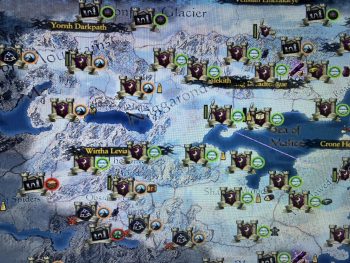 I came to Total War way back when, through TW: Rome. Arriving in 2004, it was the third game in the TW series, after Shogun, and Medieval. I liked it, though I wasn’t addicted – as I was to many games back then. But it was fun marshaling armies, and then marching them out to crush your enemies. I talked about it a little bit a few weeks ago in my RTS overview (man, Myth: The Fallen Lords was such a great game!).
I came to Total War way back when, through TW: Rome. Arriving in 2004, it was the third game in the TW series, after Shogun, and Medieval. I liked it, though I wasn’t addicted – as I was to many games back then. But it was fun marshaling armies, and then marching them out to crush your enemies. I talked about it a little bit a few weeks ago in my RTS overview (man, Myth: The Fallen Lords was such a great game!).
Sort of the “What is best in life?” response from the first Conan movie with Ah-nuld:
“To crush your enemies, see them driven before you, and to hear the lamentations of their women.”
There have been over a dozen incarnations, with the Egyptian-themed Pharaoh just dropping in 2023. What I’d LOOOOOVE, is for them to get the license from the Tolkien Estate and do TW: Middle Earth. I enjoyed Battle for Middle Earth I (never played II). But even a decently-done TW: Middle Earth would be FANTASTIC!!!!
Anywhoo. I’ve never done the Warhammer thing, but TW: Warhammer I came out in 2016. And TW: Warhammer II followed the next year. WH II has become the rabbit hole I periodically jump down. This game is — as my buddy Tony dubbed Diablo II long ago — electronic crack.
If you have WH I, you can use those factions/lords some in WH II. But you don’t need them at all. And while the base game is more than enough, part of the TW fun is buying the DLC – they add heroes, factions, and even a few campaigns. I don’t have WH III, but I the model is the same.
I have all the DLC for both WH I, and II. They are frequently 50% off+ on sale. Total War keeps ‘old’ product at original prices. It’s an annoying business model, and they do a boatload of DLC. But the base games have more than enough content. I just like the extra stuff to check out. And you don’t have to buy it, off course.
The Game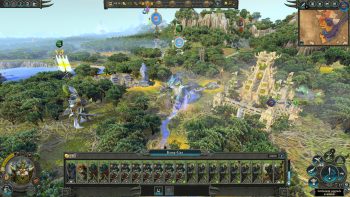 Some basics about Total War – at least, the Warhammer II version. The principles of the series are generally the same. You know what you’re getting, but the engine has evolved over the years. Warhammer II is pretty similar to I. I have not played III yet. I tried to go back to Rome Remastered earlier this year, and that old engine just didn’t work for me anymore.
Some basics about Total War – at least, the Warhammer II version. The principles of the series are generally the same. You know what you’re getting, but the engine has evolved over the years. Warhammer II is pretty similar to I. I have not played III yet. I tried to go back to Rome Remastered earlier this year, and that old engine just didn’t work for me anymore.
The general concept is you take charge of a faction (Elves, dwarves, vampire pirates, etc. In other games it’s Roman families, or medieval countries. You get it).
You build up settlements, and armies on a unit basis, for your faction. You can choose to fight the battles yourself (usually advantageous in outcome) or use auto-resolve. I find the battles time-consuming and not that much fun, so I auto-resolve. The benefits of auto-resolve seem to be reduced from winning the actual fights yourself, though.
Terrain matters in battles, and also on the global map. Dwarven settlements thrive in mountain regions. The vampire lords corrupt the land, making it less/unsuitable for some factions. The lizardmen are primarily in the jungles. So, the faction you choose often impacts what part of the world you start in, and where you choose to expand to.
You attack other armies, and settlements, or colonize ruined ones. You build them up, gaining advantages if you control all the settlements in a single province. You have to balance chasing quests, conquering settlements, and being strong enough on defense to protect what you already have. Random wandering warherds, or rogue armies (frigging pirates) can seriously blow up your plans.
You can form military alliances (as can your enemies), and when you’re strong enough, you can make a confederation with a same-race faction: absorbing all their assets – and their financial obligations!
I just keep playing and trying to expand without a debacle happening. The first ten to fifteen turns usually indicate whether I’m gonna be able to make a go of it with this faction.
Two Game OptionsThe base campaign is Battle for the Vortex. There are game-given quests, and faction quests as well. You try to build up your settlements and armies, eliminate enemies, and accomplish the various quests. I’ve never made it to the end game. Even on Easy, the computer AI is a pain in the ass. I’ve rarely made it past 100 turns before it got too messed up.
WH II also has a Mortal Empires option. It lets you pick any lord/faction from I or II, and compete against all the other factions. Last one standing wins: No over-arching campaign. I’ve played Mortal Empires a few times, and it’s a neat option, but I prefer playing the official campaign. So….
‘Guns or Butter’‘Guns or butter’ is an old economic model that shows how governments have to choose between spending for defense or domestic uses. TW play is a variation on that which is pretty much the over-arching element of the game.
You can primarily choose to spend gold on military units, or settlement buildings (there can be a couple other options, like temporary enhancements, but you’re mostly putting your gold into your settlements, or your armies).
And your armies (you start with one, but need multiple ones to survive) have upkeep costs. So, you have a one-time cost to add the unit, then an ongoing cost per turn, to keep it. The bigger your army, and the more advanced the units you use, the greater your upkeep. Which means less gold for your settlement buildings.
Each Province has a capital settlement, with five levels. And except for a couple exceptions, one to three minor settlements, with three levels. You build up your Province Capital, which opens up additional slots for new buildings. There can be a total of ten building slots in a Capital, and there are usually only three additional slots in a minor settlement.
Building Categories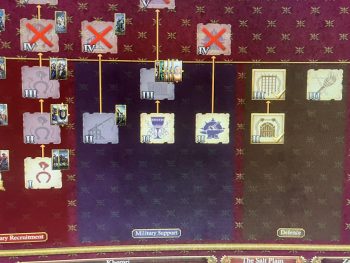 Choosing available options for a small settlement slot
Choosing available options for a small settlement slot
There are different types of ‘chains’ you can pick your settlement upgrades from. I really like this part of game management. And it’s essentially guns or butter. They have different classifications for different factions, but that’s just wording.
Resources – Available in certain settlements. They provide specific goods, like tradable resources (hides, marble, clay), plaques (related to some faction goals), or other benefits. Most settlements do not have this option, so I often take whatever it is. It’s nice when it’s a gold mine, as that is the best source of gold in the game.
Military Recruitment – These produce basic, and advanced, military units.
Basic buildings usually only have three levels, and you can start them when your Province Capital is only first level. They usually offer some other minor benefits, but this is where the meat shields and lower-level units come from. You build your starter armies here.
Advanced buildings usually go up to levels four or five, and provide elite units and enhancements. You need advanced units to get through the middle, and end, games. Purely gun stuff here.
Military Support – These buildings support your armies, lords (Each army is led by a lord), and heroes (a hero is a unique unit that can perform helpful actions and also provides benefits), and settlements. They might make recruitment costs less, reduce your casualty replenishment rates, or let you recruit infantry units with shields. More guns.
Defense – This a limited category, usually letting you add walls to your settlements, or some other defensive improvement for it. I always add walls to smaller settlements, but otherwise, this is my least-used category. As the title implies, this is a defensive category and kind of feels like a mix of guns and butter.
Infrastructure – Here you really get into the guns or butter dichotomy. There’s a wide range of options. Your main gold-making options are here. Also, you can focus on growth (how fast your settlements expand), and public order (if public order gets to-100, you have to put down a rebellion).
There are a lot of options here. Since you only get three additional slots in a smaller settlements, the choices are important. I do try to put up walls in small ones, so, with the Capital building, you only have two free slots. And you’re really choosing between guns and butter.
Misc. -Some settlements have Ports, and some have Landmarks. Ports generate gold and have their own chain. Landmarks are unique to a specific settlement and offer some benefit often worth taking. Even if it’s just a one-level use of a slot.
Choosing Your BuildingThe game randomly has factions declare war on you. And you can also end up at war with other factions through diplomacy options (that’s part of a follow-up post). You need to build up your first army in a hurry (you start the game with a lord and a small army of five-eight units, usually). Some faction is already pissed at you.
It’s tempting to use an early slot to pick a chain with a new military unit. You can get a more diverse, more effective, army, right out of the gate. Guns over butter.
But you gotta pay for all these troop units, and the constantly being constructed new buildings. So, taking that industrial building with a big per turn revenue, is tempting. The gold mine is a no brainer. In a small settlement (remember, only three slots in addition to the Capital), I almost always choose the max revenue building first. I need that stream started to build that first army.
The third (and last) slot usually goes to walls, which help with defense if you end up under siege. It’s the second slot that lets me shade towards guns or butter. For purposes of this discussion, growth and other things that primarily affect the settlement, or my revenue stream, are butter.
Since the capitals have eight to ten slots, and they go up to level five, I tend to use them for the advanced military buildings, to maximize my firepower. Some support, and non-military buildings go up to level five, so you have to factor that in as well. And walls never hurt.
TechnologiesFactions have unique Technology trees. Some are easier to develop than others. But they also reflect the guns or butter dilemma. Especially early on, you can choose technologies (which take multiple terms to develop) to enhance troop unit strength. And also to decrease recruiting costs.
Alternately, technologies that enhance your revenue stream can be vital in providing gold to maintain your growing army. Or building up your settlements.
And any time you can increase your growth or public order, you need to weigh those as immediate needs against those other areas. Butter.
Army Units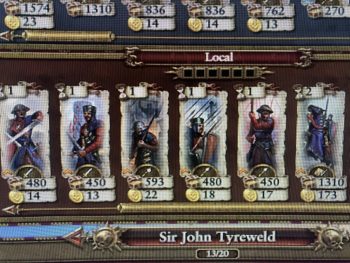 Basic units (like spearmen, or archers) cost a lot less to hire recruit and maintain, than ones such as knights, war eagles, or catapults. The stronger your army, the more it’s gonna cost you. And by mid-game, your main armies had better not still include a bunch of grunts; even if they have leveled up. You needs some higher power units.
Basic units (like spearmen, or archers) cost a lot less to hire recruit and maintain, than ones such as knights, war eagles, or catapults. The stronger your army, the more it’s gonna cost you. And by mid-game, your main armies had better not still include a bunch of grunts; even if they have leveled up. You needs some higher power units.
Armies are capped at a total of 20 units. Do you want a second full-size army? Or two medium-sized ones? Recruit a lord and build a 6 unit army to provide a military presence in a province with falling public order? All those units have an ongoing cost every turn…
You have multiple layers of guns or butter to decide upon. Bad things start to happen if your revenue stream goes negative. And enemies can raid your province, decreasing revenue. Or sack, burn to the ground, or even take over your settlements. And those things can hit your stream.
So, you need to have armies ready not only for attack, but defense. Again – that takes gold.
Wanna hire more lords or heroes? Cha-ching!
In the pic to the right, recruiting a knight will cost about three times as much as recruiting the spearman at arms next to him. But maintaining him each turn will cost ten times more.
So…Budgeting is the allocation of resources among multiple activities. Total War is strategic and tactical game of allocating resources. And basically, you decided whether to spend your gold on guns or butter. And you need the butter to make more gold. To pay for the guns.
I know folks who like playing out the battles. I have fought my share over the years, and I get it. But the faction management part of the game is what keeps me coming back. Guns or butter.
Crusader KingsA quick mention of another game.
For a kingdom management-and-war type of game, the Crusader Kings line (three so far) looks to be the standard. I have tried the first game a few times, and it’s got a MASSIVE learning curve. I think it’s manageable, I just haven’t been motivated to master the basics enough to continue on. But it does look like an awful lot of fun if you figure it out.
Next TimeThere will be a follow-up Total War post, in which I’m going to talk about how I recently had two of my most successful games by applying principles contained in George Washington’s Farewell Address. That was actually the original intent of this post, but I really enjoyed the guns or butter discussion.
Other Video Gaming Posts
RTS’ and Myth: Fallen Lords
Mount and Blade – Part One
Mount and Blade – Part Two
Steamed: What I’ve Been Playing (December, 2023)
Steamed: What I’ve Been Playing (October, 2022)
Fortnite (one of several mentions)

Bob Byrne’s ‘A (Black) Gat in the Hand’ made its Black Gate debut in 2018 and has returned every summer since.
His ‘The Public Life of Sherlock Holmes’ column ran every Monday morning at Black Gate from March, 2014 through March, 2017. And he irregularly posts on Rex Stout’s gargantuan detective in ‘Nero Wolfe’s Brownstone.’ He is a member of the Praed Street Irregulars, founded www.SolarPons.com (the only website dedicated to the ‘Sherlock Holmes of Praed Street’).
He organized Black Gate’s award-nominated ‘Discovering Robert E. Howard’ series, as well as the award-winning ‘Hither Came Conan’ series. Which is now part of THE Definitive guide to Conan. He also organized 2023’s ‘Talking Tolkien.’
He has contributed stories to The MX Book of New Sherlock Holmes Stories — Parts III, IV, V, VI, XXI, and XXXIII.
He has written introductions for Steeger Books, and appeared in several magazines, including Black Mask, Sherlock Holmes Mystery Magazine, The Strand Magazine, and Sherlock Magazine.
The Gorey Century
Yesterday was the 100th birthday of Edward Gorey, one of the most unique, unclassifiable artists that this country has ever produced. Though he died in 2000, he has a continuing cultural presence; he certainly lives on in my life and in the lives of a great many people.
Back in the incumbency of Jimmy Carter, when I was studying theater and living in the dorms of California State University Long Beach, one year I had a roommate named Scott. Scott didn’t fit into our tight-knit little community very well, and while I’ve always prided myself on my ability to get along with everyone, I didn’t get along very well with him. We had a bumpy year together, but I will always be glad that we were roommates, because Scott introduced me to the work of Edward Gorey, and that was a priceless gift that I can never repay him for.
Edward Gorey was a man of many talents — He did scenic and costume design for the stage, winning a Tony Award in 1978 for his costume designs for Dracula (his set design for that production was also nominated) and several of his stories are about ballet, which was one of his supreme passions. Additionally, he did highly individual book covers; for several years he did them for Anchor Paperbacks (including, among many others, editions of H.G. Wells’s The War of the Worlds, Franz Kafka’s Amerika, and T.S. Eliot’s Old Possum’s Book of Practical Cats), which are highly prized today simply for their Gorey covers. He also edited and illustrated a collection of classic ghost stories (1959’s Edward Gorey’s Haunted Looking-Glass) and did covers and illustrations for several of the supernatural mysteries of John Bellairs.
Beginning in the mid-1950’s, Gorey wrote and illustrated his own very short books, and these are the works that his fame mostly rests on. (Many were published under absurdly comical names that are anagrams of his own, like Ogdred Weary or Mrs. Regera Dowdy.) Visually, they are almost always set in the Victorian or Edwardian era (the closest to our own time that I can ever remember him coming was the 1920’s) and are full of bizarre, grotesque, violent, comic, cryptic, and occasionally supernatural incidents, often involving children; in fact, they are usually “children’s books” in form if not in content. The original small hardcover volumes are hard to come by and are pricey when you can find them, but there are four large omnibus volumes, each collecting a dozen or more of the short works — Amphigorey (1972), Amphigorey Too (1975), Amphigorey Also (1983), and Amphigorey Again (2006).
The first thing of Gorey’s that I ever read was “The Hapless Child”, which chronicles the travails of a lovely little girl named Charlotte Sophia. When the story begins, she’s safely ensconced in the bosom of her loving family (“Her parents were kind and well-to-do.”) Then her father, a military man, is reported killed in a native uprising and her grieving mother wastes away and dies, leaving the girl in the cold, utilitarian hands of the family lawyer, who loses no time in sending her to a boarding school where students and staff range from the merely unsympathetic to the positively sadistic. Things rapidly go from bad to worse, and from this point on, the hapless child is subjected to every horror that could befall a person in the most lurid melodrama, all rendered by Gorey in deadpan language and meticulous pen-and-ink images. Things don’t end well for the poor child, and the first time I read her tale, tears rolled down my face, but they weren’t tears of sadness; I was literally shaking with laughter. (Once the story almost got me thrown out of the college library where I was supposed to be working, when I showed it to a friend who was unacquainted with Gorey. We just couldn’t control ourselves.)
It does no good to try and explain to someone who is appalled by “The Hapless Child” rather than delighted by it that what’s being mocked is not the suffering of an innocent child (there was no Charlotte Sophia — Gorey made her up) but rather the reflexive, self-indulgent sentimentality of a hypocritical era and of readers still shackled to its sticky standards. (And one of the things that makes Gorey a complex artist is that he both recognizes the deficiencies of the Victorian age while at the same time clearly adoring many aspects of it.) Either Gorey lands with you or he doesn’t. For myself, there’s nothing that I like more than a good, Gorey story.
Other Gorey delights are “The Willowdale Handcar”, a series of strange, seemingly disjointed incidents that can, with a little imagination and a close examination of the illustrations, be connected into a coherent (if admittedly dark) narrative. (The story features The Black Doll, a sinister, featureless figure which haunts the edges of many of Gorey’s works.) Gorey could be genuinely frightening, as in “The Insect God”, in which huge insects kidnap children and mercilessly sacrifice them to their chitinous deity, and “The West Wing”, a succession of wordless images showing various rooms in a house that you definitely wouldn’t want to spend any time in. (Gorey could make a patch of peeling wallpaper radiate unease.)
Gorey would sometimes make mere objects his protagonists. In “The Inanimate Tragedy” Pins, Needles, a Glass Marble, a Four-Holed Button, and a Piece of Knotted String become embroiled in conflicts and misunderstandings that end in murder and suicide, if those terms are applicable to the fates suffered by a Half-Inch Thumbtack and a No. 37 Penpoint. Gorey would probably say that the word “tragedy” is no more out of place with junk-drawer contents than it is with the equally mundane and transient objects that we call human beings, and in “The Abandoned Sock” you feel genuine apprehension for the sock who foolishly deserts his mate on the clothesline to go adventuring and gets used for a dust rag, chewed by a dog, caught in a tree, and picked apart by birds to use for their nests until nothing is left of it. Does the sock’s life (which it found “tedious and unpleasant” when it was pinned on the line next to its dull mate) turn out all that differently from our own personal dramas?
One of Gorey’s most famous stories is “The Doubtful Guest”, which sees an odd, penguinish-looking creature attired in tennis shoes and a striped scarf turn up one night at the house of a settled, respectable (boring!) family and proceed to turn things upside down. Without ever uttering a sound, the uninvited visitor eats the plates at dinner, tears chapters out of books, suffers fits of bad temper during which it hides all the bath towels, safeguards objects that it takes a liking to (like expensive pocket watches) by dropping them in a pond, eerily sleepwalks up and down the hallways at night, and otherwise disrupts the placid routines of the baffled family, who have no hope of ever going back to life as it was, because “It came seventeen years ago — and to this day / It has shown no intention of going away.” (Many of Gorey’s stories are written in verse.) You understand the family’s frustration and despair, but you may also feel that a little unpredictability might do them some good. I have my own Doubtful Guest — a college friend of my wife made him for me, and I was delighted to learn that Gorey had several himself, that admirers had made and sent to him. (I have a Black Doll too, but that I had to buy.)
Gorey did several alphabet books; the most well-known (images from it have appeared on calendars, tee-shirts, coffee mugs etc.) is “The Ghastlycrumb Tinies.” Here dewy-eyed tots come to shocking and painful ends (“A is for Amy who fell down the stairs / B is for Basil assaulted by bears / C is for Clara who wasted away / D is for Desmond thrown out of a sleigh). Gorey doesn’t imply that these grim events are the children’s faults, but he doesn’t imply that they aren’t, either.
Gorey wasn’t uplifting or heartwarming, (except perhaps in “The Pious Infant”, the story of Henry Clump, a little boy who is too good to live long, and thank God he doesn’t) but now and then justice is served, as it is in “The Bug Book”, one of the few Gorey stories that’s not in black-and-white. In this tale of collective security and well-earned retribution, a peaceful group of bugs have their happy society wrecked by a new bug in the neighborhood, a big, brutish interloper who, despite their best efforts to be friendly and welcoming, “broke up their parties” and “waylaid them whenever they went visiting.” After a secret meeting in the dead of night, the problem is solved by squashing the obstreperous insect flat with a big rock. His remains are placed in an envelope addressed “To whom it may concern” and a pleasant and lively social life is resumed (in Gorey’s world, clearly the happiest of happy endings).
The great Literary critic Edmund Wilson (he who disparaged detective stories and sneered at Tolkien and Lovecraft) was an early admirer of Gorey; he found the artist’s singular little books pleasingly suggestive and allusive. “I find that I like to return to them,” Wilson said. The critic was wrong about a lot of things, but he was right about Edward Gorey. Over almost a half a century, I too have continued to come back to Gorey’s strange, sinister, darkly comic world. There is truly nowhere else like it.
Edward Gorey, this contradictory man who loved attending classical ballet (he was present for every performance of the New York City Ballet for twenty-five straight years) and watching “trash TV movies on the USA Network” was sui generis, the sort of one-of-a-kind genius who can only be appreciated and enjoyed, never imitated or emulated. The mark he set was too high for anyone else to reach… or maybe it would be more accurate to say that it wasn’t too high, exactly; rather, it was too far off to the side.
Whatever deserted house, sinister garden, enigmatic landscape or dimly-lit stage your eccentric spirit now haunts, Edward Gorey, happy birthday to you. Your ashes may have been scattered to the four winds, but your work goes marching on; I fully expect your macabre miniatures to be around for at least another hundred years.
Thomas Parker is a native Southern Californian and a lifelong science fiction, fantasy, and mystery fan. When not corrupting the next generation as a fourth grade teacher, he collects Roger Corman movies, Silver Age comic books, Ace doubles, and despairing looks from his wife. His last article for us was Reading for the End of the World Redux
There, Wolves: Part I
 Werewolf Rising (RLJ Entertainment, October 14, 2014)
Werewolf Rising (RLJ Entertainment, October 14, 2014)
A 20 film marathon of werewolf movies I’ve never seen before.
As usual, the films must be free to stream.
I’ve got a bad feeling about this.
Werewolf Rising (2014) YouTubeMan or beast? It looks more like a hairy extra from The Hobbit.
Howling’ good time? Nope. We are off to a rip-roaring start with this dull effort shot entirely in Arkansas, if that floats your boat.
A paper thin plot is played out in a forest with a single digit, lacklustre cast and the whole shebang is shot in glorious murky-vision. The only redeeming feature might have been the beast(s), but they are rubbish.
Oh god. What have I started?
3/10
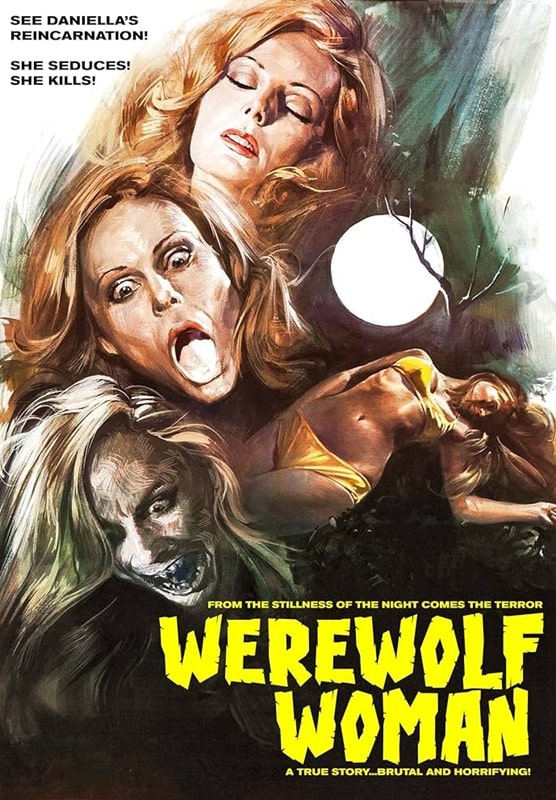
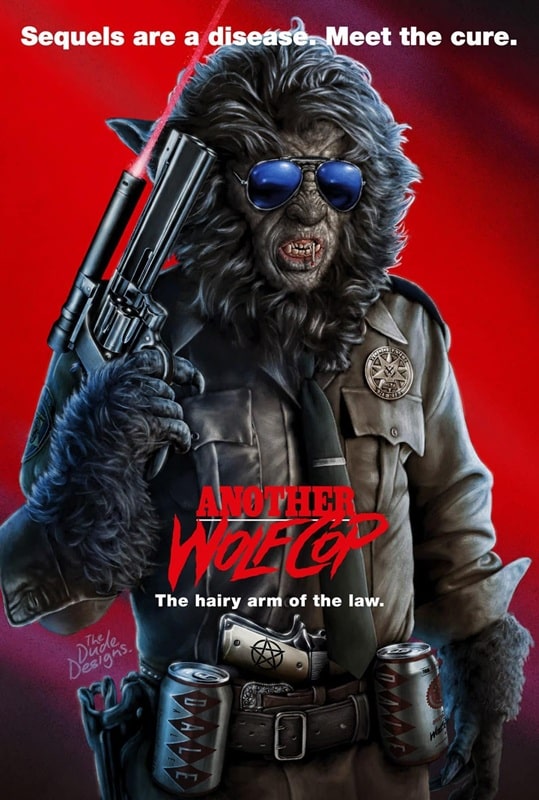
Werewolf Woman (Agorà, March 18, 1976) and Another Wolfcop (RLJE Films, July 29, 2017)
Man or beast? Naked, hairy, black-nosed lady.
Howling’ good time? Apparently, this is a favorite of Quentin Tarantino, but I swear half of his favorites are just obscure titles that he had access to while working in a dodgy video store that he could use as bragging rights. It has elements of revenge flicks that he would use in his own films, but the rest is a messy potpourri of sex, violence, and sexual violence. This being the 70s and Italian, the main feature is hair, whether it is covering the voluptuous frame of the titular lady, the upper lips of the men, or more nether-regions than a topiary enthusiast could ever dream of.
It’s a sordidly strange tale of a woman who is horrifically raped and her lover murdered, who exacts revenge in the guise of a werewolf without any transformation due to recurring dreams that she is the descendant of a werewolf. Confused? You will be. Weird, uncomfortable, badly dubbed.
Can’t say I loved it – but it had a couple of decent moments and some good old-fashioned Italian exploitation gore.
6/10
Another Wolfcop (2017) PrimeMan or beast? Great, practical, wolf. Cop.
Howling’ good time? A proudly Canadian production, this sequel takes the original concept (cop Lou Garou is bitten by a werewolf and brings his new persona to the job) and ramps up the insanity. Reptilian mutants, moustachioed parasitic stomach worms, extremely hairy sex, extremely gory deaths, Gowan on repeat and Kevin Smith yelling ‘slam a cold cock!’ at any given moment. It’s stupid as all hell and I loved it.
Bonus points for enormous werewang.
8/10
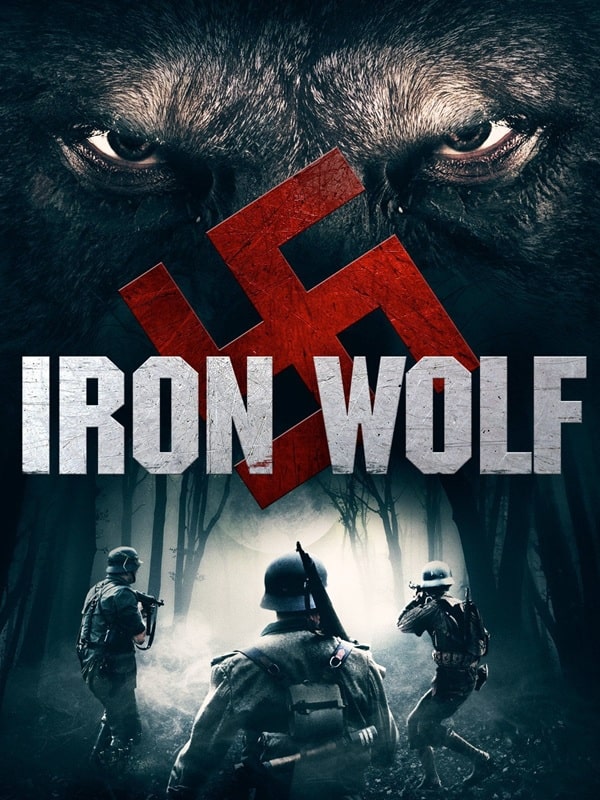
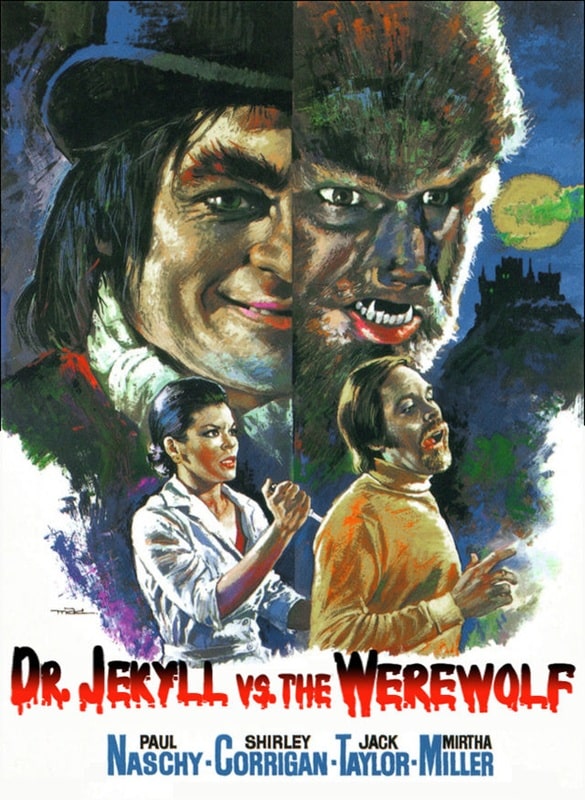
Iron Wolf (RJ Nier Films, September 13, 2013) and Dr. Jekyll vs. the Werewolf (Filmaco, 1972)
Man or beast? Ruby’s bottom of the line costume.
Howling’ good time? Don’t be fooled by the poster (or any poster for that matter), this is not a jolly werewolf romp set in WW2. The film begins that way, with some mis-matched Nazis working in a secret lab (industrial site) and showing off their werewolf that they have trained to only attack non-Nazis.
It’s cheap and cheerful, and somewhat passable, but then is brutally cut short and jumps forward in time to some extremely dull modern, German teenagers. They are hanging around the semi-ruined labs for some B.S. reason, the wolf creature gets out, and it becomes a ‘desperate fight for survival’. The direction is pretty limp, and the acting isn’t great – I really wish the German cast had been allowed to speak German and for the film to be subtitled. It makes no sense to flatly deliver the lines – lines that are flat to begin with.
As usual, the only saving grace could have been the werewolf, but this big doofus is just a dude in a Halloween wolf costume (and not the deluxe version) stuffed into a Nazi uniform. Laughably bad.
4/10
Dr. Jekyll vs. the Werewolf (1972) TubiMan or beast? Hairy-faced fella.
Howlin’ good time? I’m no stranger to Paul Naschy werewolf flicks, but this is one of the dozen movies he made that I missed. As with the other Spanish-produced films in this series, Naschy plays the wolfman, searching for a cure, and the whole shebang has that lovely dark gothic feel of the other films.
However, this one has a personality split as broad as the titular characters. The first hour is tedious, lots of sitting around talking, but then, once Dr. Jekyll’s grandson starts shooting up the wolfman, it goes batshit crazy. Cue Hyde going on a sadistic rampage, whipping every bosom he lays eyes on, go-go dancing, drunk tipping and other nefarious tomfoolery. It’s not enough to save the movie, but it is daft enough to warrant an extra mark.
5/10
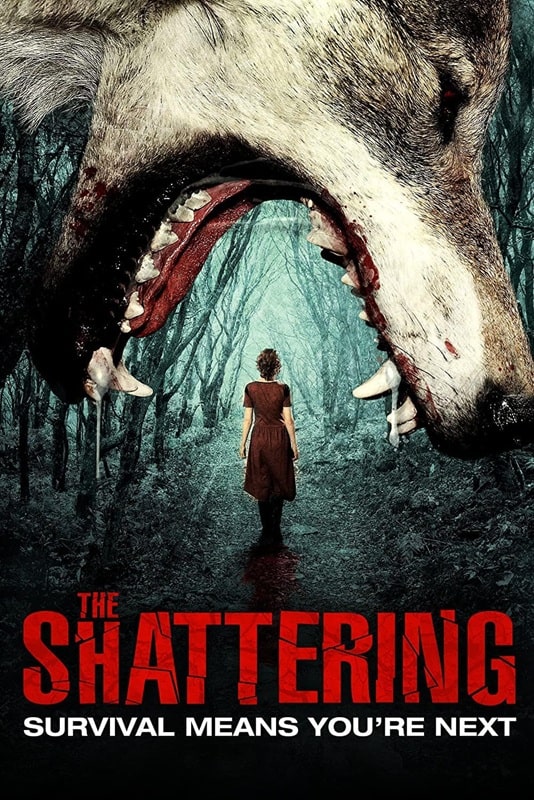
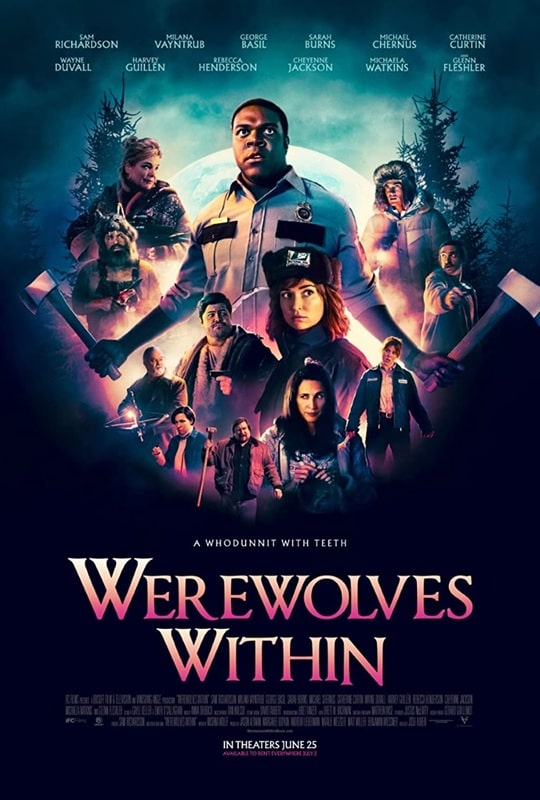
The Shattering (Film Cartel Entertainment, March 24, 2015) and Werewolves Within (IFC Films, June 25, 2021)
Man or beast? Unseen thingy.
Howlin’ good time? Let’s get this one out of the way. A group of randos are stuck in a cabin due to a bullshit plot line involving a healer. Some hunters are stuck in the woods due to some bullshit plot line about collecting wolf spit. A POV camera eats most of them. A very bold decision to not show a single werewolf in this badly shot, badly acted, werewolf flick. The only shattering that went on was in my pants when I realized I had to sit through this tedious dirge.
3/10
Werewolves Within (2021) NetflixMan or beast? Nice, practical werewolf.
Howlin’ good time? I really should have saved this until last, but I needed a little pick-me-up, and this sure hit the spot. Based on the videogame Werewolf, this film is a joy from start to finish. It’s a horror comedy in the same vein as Shaun of the Dead, even going so far as to include some Edgar Wright-type editing, and for the most part, the comedy sticks the landing.
It helps that the two leads are so likeable and awkward; Sam Richardson is perfect as a spineless park ranger, and Milana Vayntrub is adorable (and renews my pining for the aborted Squirrel Girl series). The setting is a hokey town in Vermont, full of troubled characters that put me in mind of Northern Exposure, or even Twin Peaks, and the plot weaves in a bit of social commentary about pipelines, gentrification, and acceptance.
For a further comparison, I had as much fun with this as I did with The Beast Must Die, and I even guessed correctly! Highly recommended.
9/10
Previous Murkey Movie surveys from Neil Baker include:
What a Croc
Prehistrionics
Jumping the Shark
Alien Overlords
Biggus Footus
I Like Big Bugs and I Cannot Lie
The Weird, Weird West
Warrior Women Watch-a-thon
Neil Baker’s last article for us was What a Croc, Part III. Neil spends his days watching dodgy movies, most of them terrible, in the hope that you might be inspired to watch them too. He is often asked why he doesn’t watch ‘proper’ films, and he honestly doesn’t have a good answer. He is an author, illustrator, outdoor educator and owner of April Moon Books (AprilMoonBooks.com).
The Fiction of Edgar Rice Burroughs, Part IV: The Hollow Earth and Pellucidar
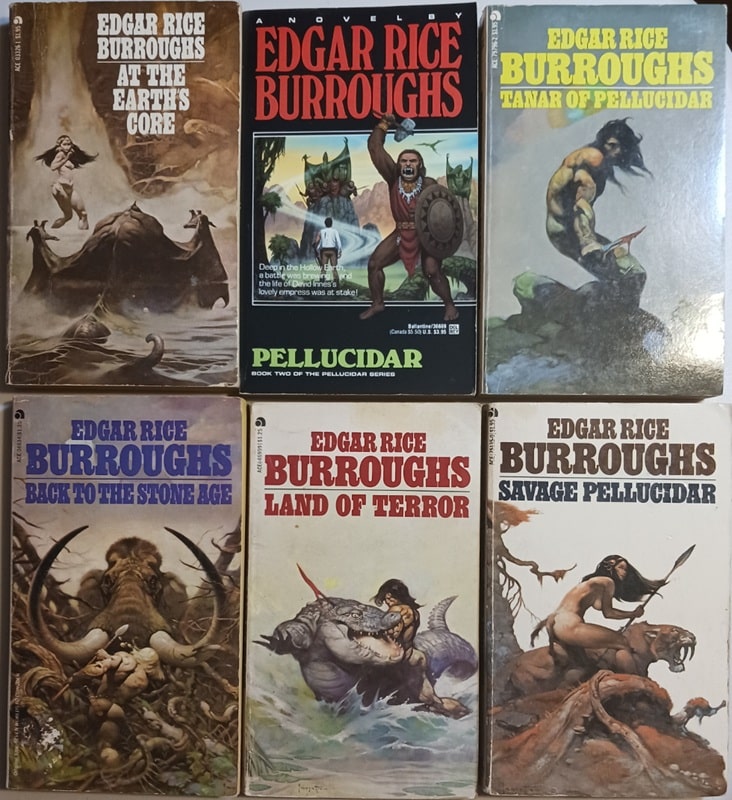 The Hollow Earth novels of Edgar Rice Burroughs: At the Earth’s Core (Ace Books, August 1978), Pellucidar (Del Rey, May 1990), Tanar of Pellucidar, Back to the Stone Age, Land of Terror, and Savage Pellucidar (Ace Books, January 1973). Covers by Frank Frazetta and David Mattingly (Pellucidar)
The Hollow Earth novels of Edgar Rice Burroughs: At the Earth’s Core (Ace Books, August 1978), Pellucidar (Del Rey, May 1990), Tanar of Pellucidar, Back to the Stone Age, Land of Terror, and Savage Pellucidar (Ace Books, January 1973). Covers by Frank Frazetta and David Mattingly (Pellucidar)
Above are my Edgar Rice Burroughs Pellucidar books. Tarzan at the Earth’s Core goes with this series as well, although I included it in Part II of this series, with my Tarzan collection. In these stories, Pellucidar is a hollow area at the center of the Earth. There are openings into it at the North and South poles, but in the initial book, At the Earth’s Core, an American named David Innes reaches the interior by riding inside a giant drill. This is kind of a reverse of the Sword & Planet plot in which the Earthman is taken outward to another world.
Pellucidar is an interesting construction and ERB clearly gave it some thought. There’s a miniature sun at the center that leads to perpetual day, and the only shadowy area on the surface of Pellucidar is an area of constant twilight beneath the bulk of the unmoving moon. The interior has no horizon because everything curves up and away from the viewer, and the land and water masses are the reverse of the surface, leaving a lot of land. The world is populated by all kinds of extinct outer lifeforms that wandered in through the polar entrances, including some dinosaurs and the remnants of the mammal megafauna.
It also contains humans, and some weird races that never existed on the surface, including the Mahars, who are winged reptilian-like beings possibly evolved from Pterodactyl-like ancestors. The Mahars rule the interior world and David Innes leads a revolt against them that is fought out during the first few books. In Tarzan at the Earth’s Core, Tarzan takes an airship into the interior world and gets involved in the war. Some of the later books are made up of stories that were originally published separately.
There are 7 Pellucidar books, listed below with first publication dates. My copies are all later releases, of course, and all from Ace Books, except for Book 2, From Del Rey. I’ve also listed the publication dates and cover artists here for my copies.
At the Earth’s Core, 1914: 1978, Frazetta
Pellucidar, 1915: 1990, David B. Mattingly
Tanar of Pellucidar, 1929: 1978, Frazetta
Tarzan at the Earth’s Core, 1929-1930 (not shown above)
Back to the Stone Age, 1936-1937: Frazetta cover (My Favorite)
Land of Terror, 1944: 1973, Frazetta
Savage Pellucidar, 1963: 1978, Frazetta
I like the Pellucidar series a lot, and it was the single biggest influence on Lin Carter’s Zanthadon, which I wrote about in a Facebook post quite a while back.
 Lin Carter’s Zanthodon novels: Journey to the Underground World, Eric of Zanthodon, Hurok of the Stone Age, Darya of the Bronze Age, and Zanthodon (DAW Books, November 1979, May 1982, February 1981, September 1981, and June 1980). Covers by Josh Kirby and Thomas Kidd (Zanthodon)
Lin Carter’s Zanthodon novels: Journey to the Underground World, Eric of Zanthodon, Hurok of the Stone Age, Darya of the Bronze Age, and Zanthodon (DAW Books, November 1979, May 1982, February 1981, September 1981, and June 1980). Covers by Josh Kirby and Thomas Kidd (Zanthodon)
The idea of a Hollow Earth that Burroughs used in his Pellucidar books, or at least of great caverns beneath the earth, is very old. Quite a few Native American tribes have origin stories that include them coming from out of hollows in the earth. Edmond Halley proposed it as a serious theory in 1692, and, of course, there’s Jules Verne’s Journey to the Center of the Earth, published in 1864.
A couple of years ago, my wife and I visited Mammoth Cave in Kentucky and saw evidence of Native Americans having visited and perhaps lived there. I also found out about a book with the lengthy title Wonderful Discovery: Being an account of a recent exploration of the celebrated Mammoth Cave, in Edmonson County, Kentucky, by Dr. Rowan, Professor Simmons and others, of Louisville, to its termination in an inhabited region, in the interior of the Earth.” I managed to find a copy online.
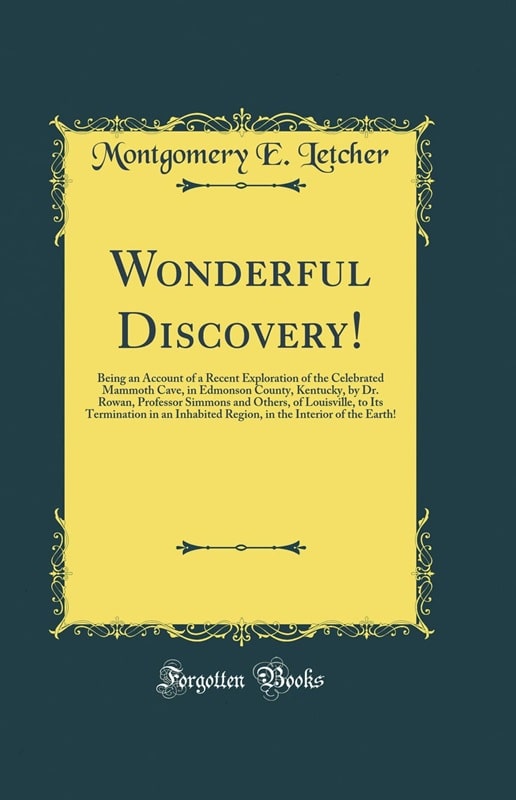 Wonderful Discovery by Montgomery E. Letcher (Forgotten Books, August 24, 2018)
Wonderful Discovery by Montgomery E. Letcher (Forgotten Books, August 24, 2018)
Written in 1839, this story purports to be a journey into the Hollow Earth through the Mammoth Cave system. It’s only a long opening chapter, and supposedly there were to be further installments. This is the only one I’m aware of. This piece has the intrepid explorers getting through the cave system into the inner world where they meet a peaceful group of humans. There’s not much excitement; no “narrative drive,” like you get from ERB.
I was unable to find anything on the author Montgomery E. Letcher. My search suggests this is the only work he ever did. The writing is, naturally, very old fashioned, and the concept was apparently derived from Halley’s suggestion of the Hollow Earth. The story precedes Jules Verne’s Journey to the Center of the Earth by decades, since that book was published in 1864. It seems likely to me, however, that Verne arrived at the idea directly from Halley’s writings rather than from having read this work. And I doubt Burroughs knew about it either.
 Map of Pellucidar from An Atlas of Fantasy by Jeremiah Benjamin Post (Ballantine Books, January 1, 1979)
Map of Pellucidar from An Atlas of Fantasy by Jeremiah Benjamin Post (Ballantine Books, January 1, 1979)
Above is a map of Pellucidar, from An Atlas of Fantasy. The same basic map is featured in some of the books as well. ERB drew it himself.
ERB and Some PastichesGetting back to ERB’s Pellucidar, there’s also a sequel to the series written by John Eric Holmes (1930 – 2010) called Mahars of Pellucidar. It follows the events of Savage Pellucidar. My copy appears to be from the first printing, from ACE, 1976, with a great cover by Boris. I actually enjoyed this tale quite a bit. It was authorized by ERB’s heirs, although they originally nixed a sequel Holmes wrote called Red Axe of Pellucidar. This was eventually published, with the consent of ERB, Inc, although I don’t have it and haven’t read it.
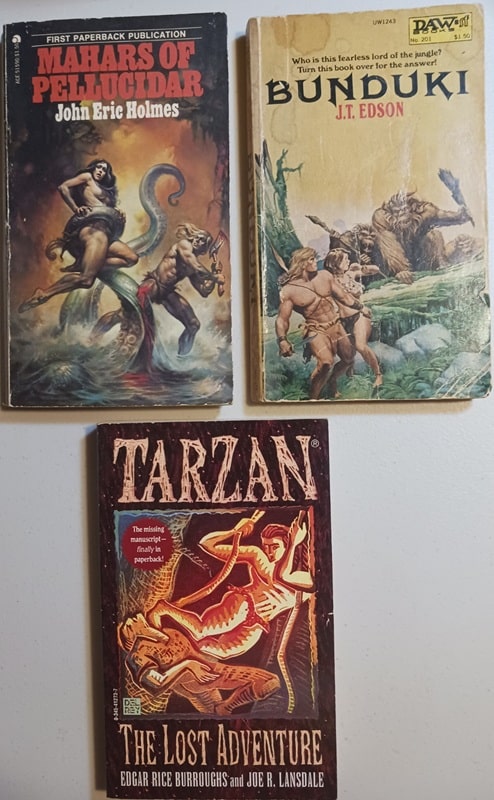 Mahars of Pellucidar by John Eric Holmes (Ace, 1976), Bunduki by J.T. Edson (DAW, April 1975), and Tarzan: The Lost Adventure, by Edgar Rice Burroughs and Joe R. Lansdale (Del Rey, June 1997). Covers by Boris Vallejo, Michael Whelan, and Raymond Verdaguer
Mahars of Pellucidar by John Eric Holmes (Ace, 1976), Bunduki by J.T. Edson (DAW, April 1975), and Tarzan: The Lost Adventure, by Edgar Rice Burroughs and Joe R. Lansdale (Del Rey, June 1997). Covers by Boris Vallejo, Michael Whelan, and Raymond Verdaguer
The other books I have shown above with Mahars is Joe Lansdale’s (1951-) fleshed out Tarzan novel Tarzan: The Lost Adventure, which he wrote from a long outline found in ERB’s effects after his death. It’s not quite a pastiche. Nor is it my favorite book from Lansdale, who has written many truly wonderful works. This is from Del Rey, first published in 1995. The cover is by Raymond Verdaguer. I’m sure this is perfectly competent work of art but it didn’t do much for me, and I don’t understand why they didn’t use one of the artists who did the great interior sketches, such as Gary Gianni or Michael Kaluta.
The last pastiche shown here is Bunduki, by J. T. Edson (1928 – 2014), cover by Michael Whelan. It features Tarzan’s adopted son and adopted granddaughter (Bunduki and Dawn). It throws us right into a mystery. Bunduki wakes up in a tree in a tropical jungle, but it isn’t Africa. He’s amazed since he was in a Land Rover that ran over a cliff and should have been dead. Dawn was with him but is missing. It turns out that the two have been mysteriously transported to another world, which turns out to be a counter-earth (opposite our Earth) called Zillikian. This makes it essentially a Sword & Planet novel, although pretty light on the sword part.
Edson wrote three approved novels of Bunduki and a fourth one and some short stories that were not approved by the ERB heirs. I’ve only read the first one but the complete series is:
1. Bunduki, 1975
2. Bunduki and Dawn, 1976
3. Sacrifice for the Quagga God, 1976
4. Fearless Master of the Jungle, 1980
Edson had written a partial fifth novel called Amazons of Zillikian, which was published in 2023. I’ve never seen it. Edson, a British author, was best known for his westerns, particularly a very long series about the Floating Outfit, which ran to 66 books. I’ve read one of those, which was rather intriguing since it involved Cowboys and Aliens.
I might have picked up the other Bunduki books but they are exceedingly expensive in paperback. They are cheap for the Kindle but I’ve got way too many books on Kindle already.
Previous installments in this series include:
The Fiction of Edgar Rice Burroughs, Part I: Sword and Planet
The Fiction of Edgar Rice Burroughs, Part II: Tarzan and The Land That Time Forgot
The Fiction of Edgar Rice Burroughs, Part III: The Westerns and The Mucker
Charles Gramlich administers The Swords & Planet League group on Facebook, where this post first appeared. His last article for Black Gate was The Fiction of Edgar Rice Burroughs, Part III: The Westerns and The Mucker.
Goth Chick News: Getting Our Heavy Metal Back…
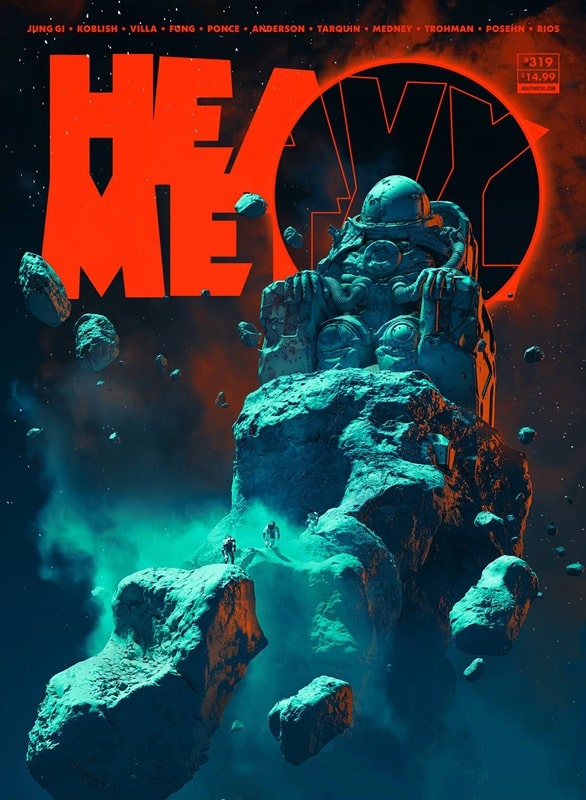 Heavy Metal #319, the penultimate issue of the original run (November 2022). Cover by Pascal Blanche
Heavy Metal #319, the penultimate issue of the original run (November 2022). Cover by Pascal Blanche
Okay, strictly speaking, this topic doesn’t fall into a standard (notice I didn’t say “normal”) Goth Chick category. But bear with me for a short story.
A long time ago in a small midwestern town far, far away, I experienced my first hardcore crush. The subject in question was not only tantalizingly a few years older than me but he was decidedly gothy in a dark-warrior kind of way. Therefore, in my youthful opinion, he was perfection on two feet. That same year as I was sitting cross-legged on the floor of my local bookstore my eyes fell on an issue of Heavy Metal magazine where low and behold was my crush, or someone who looked darn close, personified in all his brooding magicalness, right there on the cover. That day my allowance went to my first issue of Heavy Metal and though I was a rabid fan for years afterward, I admittedly became hit and miss, buying only sporadic issues throughout the 2000’s.
Heavy Metal magazine, which had been in constant publication since 1977, printed its last issue in 2022 after a series of attempts to keep it viable, and an era came to an end.
Until now.
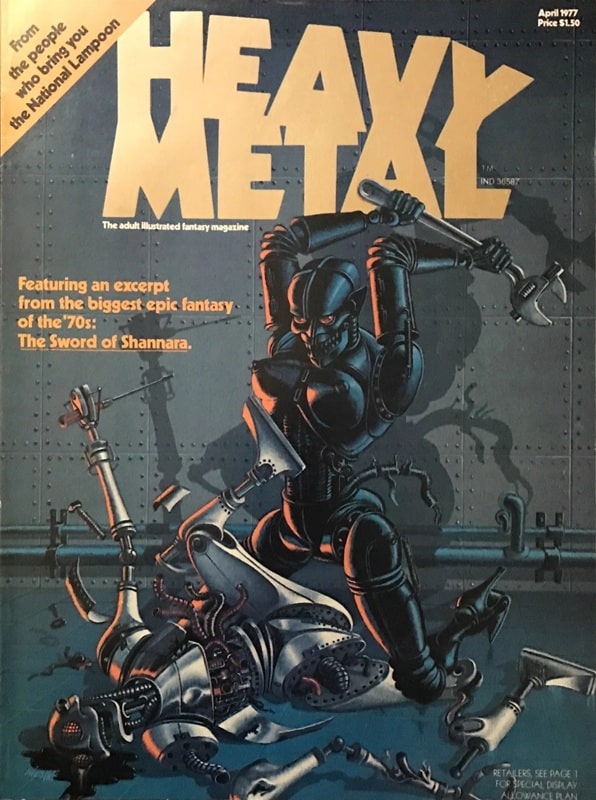 Heavy Metal issue #1, April 1977. Cover by Jean-Michel Nicollet
Heavy Metal issue #1, April 1977. Cover by Jean-Michel Nicollet
Before we get to that, let’s back up for some history.
Heavy Metal debuted in April 1977, bringing avant-garde European comic art and adult-oriented storytelling to American readers. Inspired by the French magazine Métal Hurlant (“Screaming Metal”), Heavy Metal was launched by Leonard Mogel, who licensed the rights to translate and publish content from its French counterpart. The magazine quickly distinguished itself with its blend of science fiction, fantasy, horror, and erotica, rendered in fantastic artwork and experimental narratives.
In its heyday, the contributors to Heavy Metal included legendary artists like Moebius, H.R. Giger, and Philippe Druillet, alongside American talents such as Richard Corben. Heavy Metal became the go-to publication for visionary creators, showcasing serialized stories, one-shot comics, and memorable (and boy were they memorable) covers that pushed boundaries all over the place.
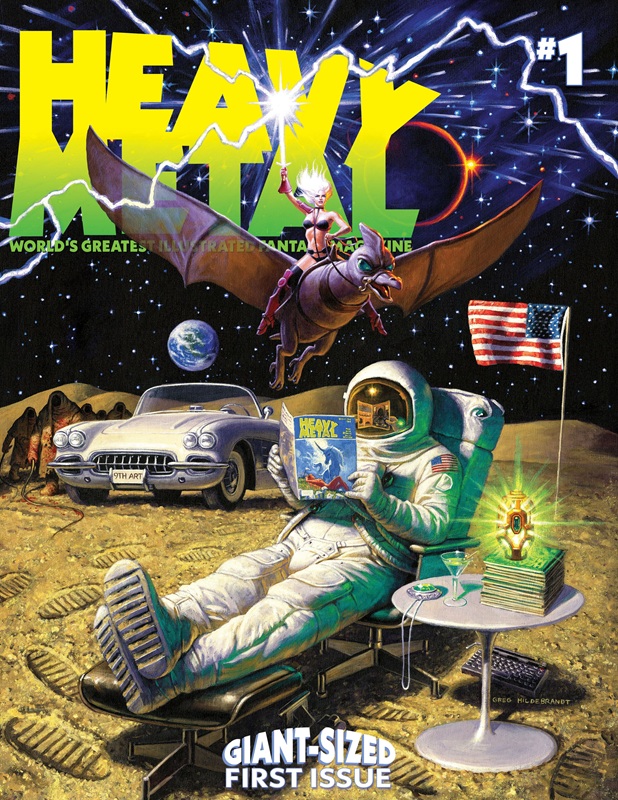 Heavy Metal #1 (April 30, 2025). Cover by Greg Hildebrandt
Heavy Metal #1 (April 30, 2025). Cover by Greg Hildebrandt
The magazine reached a broader audience with the release of the cult animated film Heavy Metal (1981), an anthology of shorts inspired by its comics and featuring a soundtrack of iconic rock and metal bands. This cemented its reputation as a cultural touchstone for fans of both countercultural comics and rock music.
Over the years, Heavy Metal evolved under various editors and owners, including Kevin Eastman, co-creator of Teenage Mutant Ninja Turtles. In January 2014, its ownership transitioned to digital and music veteran David Boxenbaum and film producer Jeff Krelitz. Eastman, though stepping back from majority control, remained as publisher until 2020 and retained a minority stake in the magazine under Heavy Metal Media, LLC.
In early 2020 CEO Matthew Medney and “Creative Overlord” David Erwin (formerly of DC Entertainment) took the helm. They launched new publishing initiatives, Virus and Magma Comix, though neither gained much traction. In 2021, Heavy Metal celebrated its 300th issue, featuring work by legendary artists and tributes to its cultural impact.
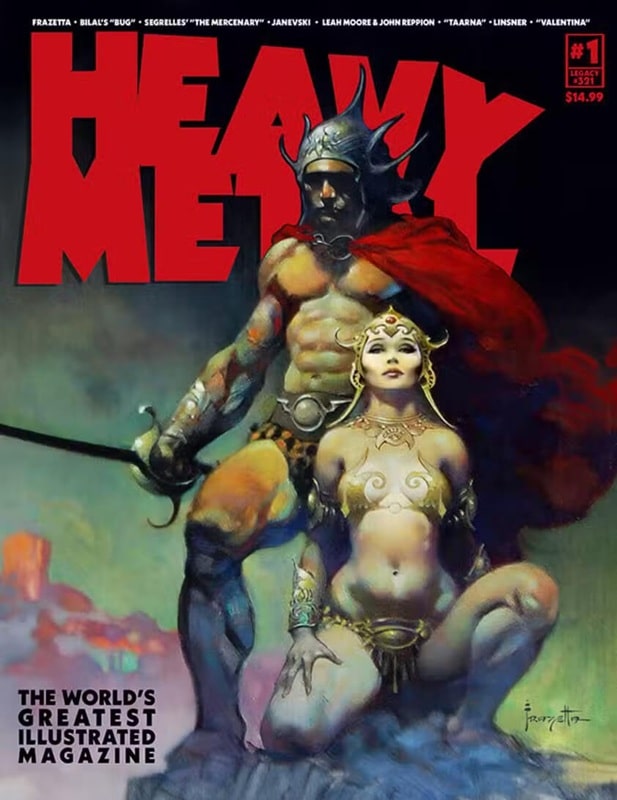 Heavy Metal #1, Sword & Sorcery variant (April 30, 2025). Cover by Frazetta.
Heavy Metal #1, Sword & Sorcery variant (April 30, 2025). Cover by Frazetta.
Financial struggles loomed, leading to a partnership with Whatnot Publishing in 2022 to produce future issues. However, cash flow problems forced Heavy Metal to cease publication in December 2022, ending its continuous run since 1977. Despite efforts to revive operations and fulfill obligations, only one additional issue was produced, and the magazine was officially canceled in mid-2023.
Which brings us to today.
In October 2024, Heavy Metal International, LLC announced a relaunch planned for 2025, backed by a Kickstarter campaign to fund it. The campaign had a modest $5000 goal but nearly 11,000 fans proceeded to blow that right out of the water and contributed a whopping $781K. HMI put together this short video announcing the comeback of the magazine so check it.
Heavy Metal magazine (new) issue 1 is set to drop in April in stores, and the magazine’s website indicates that subscriptions to the new version will be available there soon. I’m definitely going to give this a look when it hits shelves to see if Heavy Metal was a point in time, or if it can be successful in this era.
Thoughts?
Following in the Steps of Robert E. Howard: The Eye of Sounnu by Schuyler Hernstrom
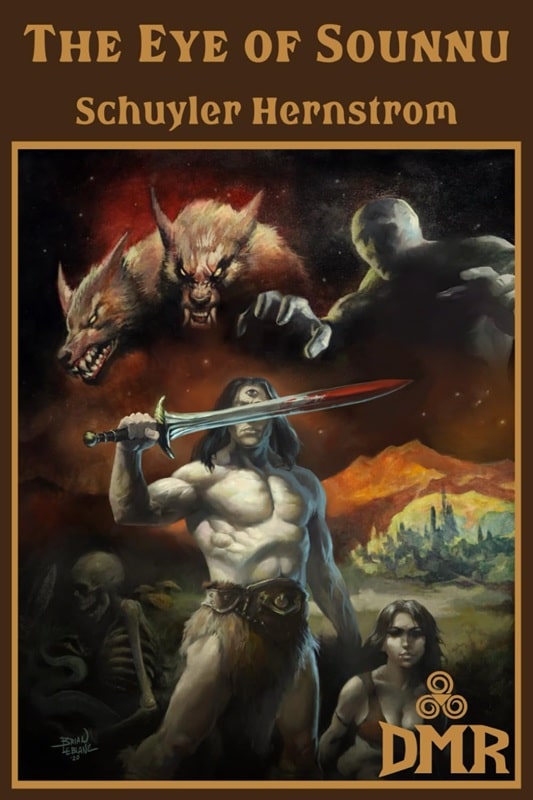
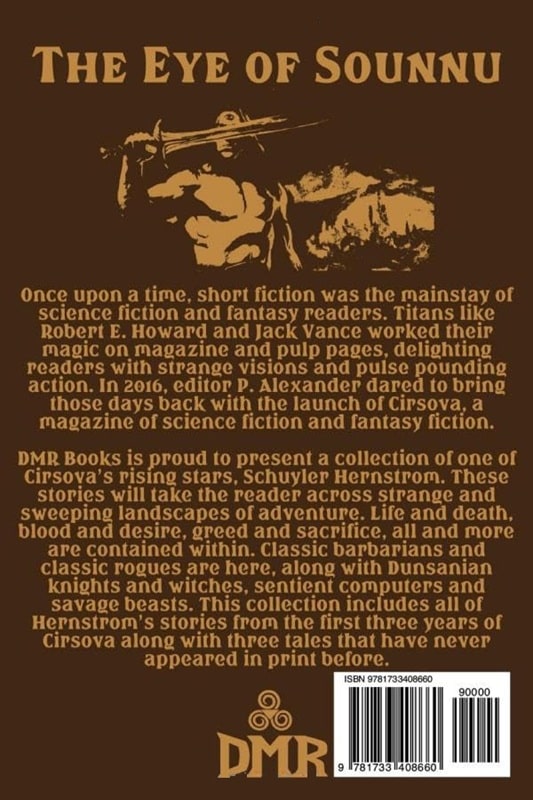
The Eye of Sounnu (DMR Books, May 3, 2020)
The concept of barbarism vs. civilization is a topic that Robert E. Howard often explored in his incredibly crafted fiction. Other authors, many inspired by Howard, have explored the concept through their own creations.
Notable among these is modern sword-and-sorcery author Schuyler Hernstrom, whose collection of short stories, The Eye of Sounnu, was published by DMR Books. The collection contains a wonderful story called “Mortu and Kyrus in the White City,” which features northland, pagan barbarian (Mortu) and his learned companion (Kryus), a monotheistic monk who suffers a curse and now lives in the body of a monkey — but that does not preclude him from waxing philosophically about the world and mankind’s place in it.
There was an exchange between the two that I recently read, and I had to reread it, and then reread it again, because I enjoyed it so much, so I share it here, for my friends of similar interests.
(This takes place shortly after the two arrived in “the White City.”)
Mortu whispered to his friend. “How old do you reckon she is?”
Kyrus shrugged. “Perhaps thirty-five, forty? Forty-five at the oldest.”
“Everyone here, the men and the women, all seem to be the same age save Nathia and the (two) children. Where are the families? Where are the elderly?”
“In mankind’s long history, many people have struck off in order to found their idea of a utopia. I suspect the denizens of the White City are such a group. All those that turn away from society in such a way meet a similar fate, gradual disillusionment and dissolution.”
“Utopia?”
Kyrus’ tone became pedantic. “A perfect society.”
Mortu scoffed. “There is such a place, the north, where my people live as the gods intended.”
“My young friend, once again the essential concepts escape your grasp, like eels slipping from your thick fingers. While you may wrongly believe the savages that raised you to be of a perfect society, I refer to man’s long dream of living without inequality or strife.”
The barbarian scoffed again. “Life is conflict. We are but wolves that walk on two legs. Build your temples, write your books, nothing will ever change.”
Lastly, I’d like to thank my friend Morgan for recommending this excellent collection a few years ago. I am enjoying it immensely.
Order copies directly from DMR’s website.
Jeffrey P. Talanian’s last article for Black Gate was Roy Thomas’ Barbarian Life. He is the creator and publisher of the Hyperborea sword-and-sorcery and weird science-fantasy RPG from North Wind Adventures. He was the co-author, with E. Gary Gygax, of the Castle Zagyg releases, including several Yggsburgh city supplements, Castle Zagyg: The East Mark Gazetteer, and Castle Zagyg: The Upper Works. Read Gabe Gybing’s interview with Jeffrey here, and follow his latest projects on Facebook and at www.hyperborea.tv.
New Treasures and Interview: C.S.E. Cooney’s Saint Death’s Herald
Black Gate’s interview series on “Beauty in Weird Fiction” queries authors/artists about their muses and methods to make ‘repulsive things’ become ‘attractive.’ We’ve hosted C.S. Friedman, Carol Berg, Darrell Schweitzer, Anna Smith Spark, and Janet E Morris (full list of 29 interviews, with Black Gate hosting since 2018).
This round features C. S. E. Cooney (CSEC), who is no stranger to Black Gate [link to listings]. She is a two-time World Fantasy Award-winning author: first, for Bone Swans: Stories, and most recently for Saint Death’s Daughter. Previously on Black Gate, an all-star crew heralded its release with a video cast including readings of Saint Death’s Daughter by C.S.E. Cooney.
Forthcoming in April 2025 is Saint Death’s Herald, the second in the Saint Death series. In this post, we reveal exclusive details, CSEC’s creative process, and hint of Book #3’s contents! Read this and her contagious energy will infect you! Cripes, simply by doing this interview, I was infected with a buttery aura! Read more and learn C.S.E. Cooney’s real identity and code name too (Tiger of the gods? Or is it Lainey!)
An Interview with Saint Death’s Daughter (a.k.a. C.S.E. Cooney)SEL: Saint Death’s Daughter was released in 2022, and we’ll dig into that momentarily. Mark Rigney interviewed you a decade ago Black Gate (2014 link). How have you changed as an author since then? Were you inspired by your Lord Dunsany readings?
Re-reading that 2014 interview is hilarious. And exuberant. And painful. Oof. That line towards the end about Howard making me read Lord Dunsany? Seth, I have to say that right now, I just want Howard alive again, and making me read anything at all. That’s what I want.
[SEL Sidebar: Howard Andrew Jones, Black Gate print magazine editor, longtime author, and friend/mentor to countless writers, passed away this January after battling aggressive brain cancer. CSEC led the charge with a GoFundMe campaign for his family (with help from a crew including the just-mentioned Mark Rigney), and Black Gate has hosted several tributes (i.e., from John O’Neill, Jason Ray Carney, & Bob Byrne); as one of HAJ’s Skull Interns, I am capturing links to many more memorials. Peace to our dear friend.]
Otherwise, sadly: I don’t recall much about my Lord Dunsany readings. I didn’t even remember that reading Dunsany made me want to be referred to as “the tiger of the gods.” Now, why didn’t that catch on, I wonder? You may henceforth refer to me in this interview as “tiger of the gods,” please.
Have I changed as an author since then? Yes. Yes, I’m not as fast as I was ten years ago, and everything about the world seems harder, and sadder. I think it was always hard and sad, but I’m feeling it more now, I guess.
But also… also, it’s all so much more interesting.
Over the last ten years, I’d experienced such burnout, such weariness and bitterness about the craft, that at one point I announced I wasn’t going to write again until I wanted to write. My friends and family were afraid I was serious. (I was.) They were like, “Claire, what are you doing?”
But I really just wanted to want to write. Was any of the work even worth it if I didn’t want it anymore?
And it took a few weeks of me staring out a window, giving myself permission not to write. But then, suddenly and spontaneously one morning, I had one of those magical “what if” thoughts. That was something that hadn’t happened in literally years of revision and submission and revision and submission. The next morning, that “what if” had built into a whole dang story idea. So I sat down and started writing it out long hand — something I’d also not done in years. The experience was so pleasurable, so permissive, and so, I don’t know. Healing.
The whole world seemed new. Writing was possible again. Phew! I’d made it through the wasteland and to the other side.
Since then, the whole creative process just keeps getting weirder and more wonderful. Concentrating on the unique bizarreness of process has really opened me up to so many branching avenues of boundless curiosity.
Now I know: if I need to stop writing for a while, I will. (After I meet my deadlines, of course. That’s what a professional does.)
For me, the sensual ritual of writing has become the point. And community. Community is the point.
What else has changed? I’ve never done so much body mirroring while writing in my life: writing in silent zooms, or with people in the room. I’ve never done so much timed writing. I even started listening to music while writing — which I never used to do. I still can’t listen to anything with words (some Hildegard von Bingen chanting aside). I started listening to fantasy gaming soundtracks, because if I listen to movie soundtracks, I just have that movie’s story and dialogue running through my brain. But since I’ve not played most fantasy games, that’s not a problem. (I can’t, for example, listen to the Baldur’s Gate soundtrack, because I did play that. Which was awesome.)
I know this now: even when I’m sad, and tired, and lacking all motivation, I still want to want to write. All the rest is hacking my brain to get the motor running. Music, company, handwriting, candlelight… all of those rituals put me in a more celebratory and ludic headspace for writing.
What’s the same? Well… every time I have to write something new, it’s still like learning how to write all over again. Some of the same skills apply, sure, but I’m constantly learning how to write something I couldn’t even fathom before I started.
Like fight scenes. Fight scenes are so hard.
“Henceforth refer to me in this interview as ‘Tiger of the Gods’ ” — C.S.E. Cooney Saint Death’s Daughter (2023 World Fantasy Winner) Blurb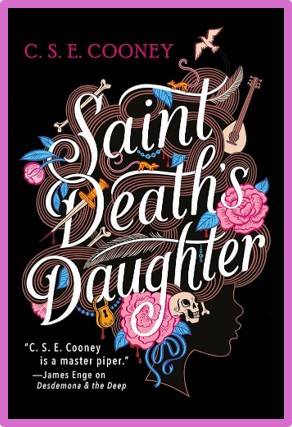
Nothing complicates life like Death.
Lanie Stones, the daughter of the Royal Assassin and Chief Executioner of Liriat, has never led a normal life. Born with a gift for necromancy and a literal allergy to violence, she was raised in isolation in the family’s crumbling mansion by her oldest friend, the ancient revenant Goody Graves.
When her parents are murdered, it falls on Lanie and her cheerfully psychotic sister Nita to settle their extensive debts or lose their ancestral home — and Goody with it. Appeals to Liriat’s ruler to protect them fall on indifferent ears… until she, too, is murdered, throwing the nation’s future into doubt.
Hunted by Liriat’s enemies, hounded by her family’s creditors and terrorised by the ghost of her great-grandfather, Lanie will need more than luck to get through the next few months — but when the goddess of Death is on your side, anything is possible.
At first glance, the summary of Saint Death’s Daughter sounds like a horror adventure, but it reads more like a comedic/fun, coming-of-age story. How would you describe the book to new readers?TIGER OF THE GODS: Generally, I give this elevator pitch: “Girl grows up in a family of assassins, but is allergic to violence. Her allergy indicates that one day, if she survives long enough, her aversion to violence will be so strong, she’ll be able to RAISE THE DEAD.”
Boom! Necromancy book, baby.
For comp titles, I say something along these lines: “Like if Terry Pratchett and the Addams Family had a necromancer baby who really liked pink frilly dresses and cutie patootie mouse skeletons.”
Those are light, easy ways about talking about my book. My book which is, in reality… much weirder.
BUT! I really don’t want to intimidate people. I want to invite people.
I also like to describe Saint Death’s Daughter as a Bildungsroman — a coming-of-age story. Now, I know that all YA books must perforce be coming-of-age stories. That’s the genre. It’s just that, at no point in the drafting process, did I imagine I was writing YA with Saint Death’s Daughter. But it is still a Bildungsroman.
I am, as I was ten years ago, still under the influence of Lois McMaster Bujold. I wanted to write a character like Bujold’s Miles Vorkosigan. The first few novellas about him may have covered his childhood, but over time, we get to experience him at many ages.
Saint Death’s Daughter is just Lanie Stones’s first book. It’s just one point in the timeline of her full life — perhaps not even the most important part. I imagine her in her thirties. (Sexy beast!) Her forties! (Whoa, what a powerhouse!) I imagine her as an old woman — with even more wisdom and compassion and mischief, and far, far more powerful. (Also, probably a foodie.) I imagine her on her deathbed. I imagine future scholars writing about her as a historical figure of a certain time and place that is perhaps no more. (This makes footnotes very fun.)
SEL: Discuss the media of necromancy which feels very artistic, especially the paint-like, colored essences of panthuama and ectenica.TIGER OF THE GODS: I made up the word “panthauma” out of the words “pan” (all) and “thaumaturgy” (miracle or marvel-working). I wanted a word for sorcery that was slightly alien, so I could apply my own set of rules to it without previous reader bias. But I also wanted, in addition to that whiff of mysterious, a sense of familiarity, linguistically-speaking.
And then I wanted a new word for “death magic” that wasn’t just, you know “death magic.” “Necromancy” is the obvious word, and I do use it in the book. But its actual etymology has more to do with divining via the dead than raising them up. (All the “-mancy” words have to do with divination.) So I wanted necromancy to be a specific kind of death magic, not the word for death magic.
I wanted a new word, something more flexible, less familiar. A word that evoked ghosts! And also super fun to say. So I took a closer look at our word “ectoplasm,” and then just sort of f*&%ed with it to make “ectenica.” Just say it aloud. All those clicky consonants!
Lanie’s a bit of a synesthete, in that she associates smells and colors with magic; that’s her brain trying to process the unimaginable. So, for panthauma, when the gods are drawing close and lighting up the world with Their attention, her vision goes bright-yellow with hard edges, like faceted topaz, and her body responds with a kind of champagne-y, effervescent reaction. Her sensual reaction to ectenica is much colder. She perceived it as a sort of starry blue. And the smell of her god, and of death magic, is always some variation of citrus. Other gods have other smells. I think, to some degree, most of the sorcerers/saints in my world have synesthesia.
SEL: Celerity Stones, one of Lanie’s aunts, was also a traditional artist, and her portfolio included portraiture like “Barely There: The Exquisite Art of Excoriation, With (Predominantly) Live Models”. I’d love to see her collection. Can you tell us more about Celerity’s inspiration and art?Celerity had been much in demand for her pen and ink drawings, her sanguine sketches, her oils, watercolors, and illuminated calligraphy. Later, she won renown as an anatomical scientist. Very precise with spreader, was never easy to ignore her most famous work, The Flayed Ideal, which hung on the wall of Stones Gallery and had a way of glaring at you. Its exposed and accusatory eyeballs, rendered in oil on canvas with exquisite delicacy, followed you around the room — and very often out the door and down the hall.
— from Saint Death’s Daughter
TIGER OF THE GODS: You know those stories we have of anatomists and resurrection men in prior centuries who’d illegally dig up bodies in order to study them, to become better doctors? (I’m glad that the laws — and some minds — have changed to allow for voluntary donation in such endeavors, but for a while it was considered absolutely heinous.) And you know all those stories about how powerful people in history — doctors, surgeons, psychologists, prisons, military — exploited marginalized communities, sometimes going so far as to medically experiment on people without their informed consent, for purposes of their own research?
That’s my inspiration for Celerity Stones.
She was not a good person. She was talented and precise and obsessed with her work. But she — like the whole toxic Stones family — hurt people to achieve her greatness.
One of the reasons that the Stones family ultimately falls is that cruelty like that is not sustainable, however it sometimes seems to advance society in the moment. Undoing the Stones’s legacy, and especially the glamorization of the violent family narrative, is something that Lanie has to consciously learn how to do as she gets older.
SEL: Every time I’ve seen you at Gen Con, you are wearing impressive regalia. Do you craft the costumes? Do they represent characters?TIGER OF THE GODS: I don’t craft costumes, per se. Like, I don’t think of myself as dressing up as certain characters. But I do dress according to my mood that day — or the mood I’d like to have. Heck, I just like dressing up. When I was a kid I had a “dress-up trunk” and I just preferred every secondhand prom dress and thrift store “glass slipper” (plastic with rhinestones) and dilapidated tiara to any of my school uniforms, softball jerseys, or neon skorts in my regular wardrobe. All these years later, I still do. Only now MOST of my closet is “dress-up” trunk.
These days, if I have to dress to go somewhere where there’s an expectation of dress code, that’s when I feel like I’m in costume. Like, when I go into the booth for audiobook narration, I have to wear “soft clothes.” I think of them as “ninja clothes,” but a friend of mine said it just looked like I was wearing pajamas. But you can’t wear anything that tinkles or rustles or chimes!
I was watching a “maximalist” influencer talking on Instagram about how the act of getting dressed is a creative process. And when you put together an outfit (or “fit” as the kids are calling it) to completion, you get that little bump of dopamine, like when you finish a puzzle or complete a recipe or win a game. Creative clothing is a small, achievable goal, and it makes me happy. Maybe, in some ways, I’ve been sartorially self-medicating since childhood!
Saint Death’s Herald BlurbMuch-anticipated follow-up to the whimsical, joyous, zombie-packed World Fantasy Award-winning Saint Death’s Daughter
Lanie Stones is the necromancer that Death has been praying for.
Heartbroken, exiled from her homeland as a traitor, Lanie Stones would rather take refuge in good books and delicate pastries than hunt a deathless abomination, but that is the duty she has chosen.
The abomination in question happens to be her own great-grandfather, the powerful necromancer Irradiant Stones. Grandpa Rad has escaped from his prison and stolen a body, and is heading to the icy country of Skakhmat where he died, to finish the genocide he started. Fortunately for her, Lanie has her powerful death magic, including the power to sing the restless dead to their eternal slumber; and she has her new family by her side.
Grandpa Rad may have finally met his match.
Saint Death’s Herald (preorder link) is coming in April 2025. What can we reveal? Anything special we can say about this, only heralded via Black Gate?TIGER OF THE GODS: Oh, gosh. Well. A Black Gate exclusive, eh?
Well, here’s the thing. I LOVE spoilers. I don’t even call them spoilers. I call them SPICERS. But not everybody (not even most people) think of them that way. So, with the caveat that those people who consider any information at all a SPOILER, perhaps they could skip this part?
Hush, come close! I’ll tell you, dear Black Gate readers, that Lanie Stones has only grown in power since Saint Death’s Daughter. I’ll tell you that when she enters fully into sympathy with a dead object, she can… SHARE PARTS OF ITS SHAPE.
She is also learning how to communicate through the dead — so if she has a… a toe bone, for example, from a particular corpse, and if you have a different toe bone from that same corpse, she’ll be able to call you. Like a one-way cell-phone.
My plan is, for Book 3, that Lanie will be so good at sharing shapes with the dead, that she can basically take on and maintain the appearance of any dead creature whose accident (physical material) she is in contact with. This makes going undercover to investigate crimes against the death god (totally random plot idea, not the basis for Book 3 at all, doo-dee-doo) much easier.
Can you discuss the cover art creation and artist?TIGER OF THE GODS: Oh, this is the wonderful, wonderful Kate Forrester! Fantasy readers will already know and love her work from such glorious novels as Zen Cho’s The True Queen and Theodora Goss’s Extraordinary Adventures of the Athena Club trilogy. Basically, for Book 1, my editor Kate Coe consulted me about different cover artist options, and some ideas for the art.
When Kate Forrester was chosen, Kate Coe and I generated a few wild cover ideas to throw her way. Then Forrester came up with the wonderful silhouette idea. My editor asked if I could send the artist a few elements from the book that the silhouette could have trapped in her hair.
Then, for Saint Death’s Herald, my editor David Moore arranged the same sort of information exchange. In Book 2, the silhouette is facing the opposite direction, with different elements caught in her hair. The cover was done long before the book was done — so I had to make sure that my final draft included all the visual cues that I had originally suggested when I was still in the early stages of writing! Phew!
I wonder what Book 3 will look like? Forward facing? Or two silhouettes facing in opposite directions? That would be kind of cool: especially if Lanie spends most of the book incognito — as both herself and not herself!
But that’s years away.
“For me, the sensual ritual of writing has become the point. And community. Community is the point…even when I’m sad, and tired, and lacking all motivation, I still want to want to write” – C.S.E. CooneyI adore your character names. For example, the protagonist & heroine “Lanie Stones” has a formal name of “Miscellaneous Stones”; and her contentious grandfather Irradiant ‘Grandpa Rad’ Stones. Can we contract you to assign us pseudonyms with all the grandeur your characters’ names have? I’d love to lure you into calling me names.
Tiger: That sounds like SO MUCH WORK! But it reminds me of the Fairy Tale Heroines workshop that The Carterhaugh School of Folklore and the Fantastic runs. One of the last things everyone does is assign themselves a “fairy tale heroine” (or hero/non-binary) name. But to do this, here are some questions: What’s your favorite animal? What kind of magic user would you be? If you could choose one of these to be: human, gentry (fairy folk), or goblin, which one would you be? If you were to choose one of the 12 gods from Saint Death’s Daughter, which would you choose? What’s your favorite obscure or forgotten word?
SEL: Eh gad, return fire. Those are hard questions! Fairy and “humors” (alchemical medicinal version) … and I am still learning the 12 gods of your stories. I’m too young and ignorant to recall them all and choose (I’m not worthy). I do love Lainey and her scarecrow though.
Tiger: Okay, then, so if you were a Stones, you’d probably be named Butter-of-Antimony Stones, son of Alkahest and Argyropoeia Stones…. Friends would call you “Bu” for short. (We won’t get into what your enemies call you.) And if you were a gentry, you probably would be named Crasis, a cloudskin (sometimes “cloud — skin” and sometimes “clouds-kin”) who can transform into whatever shape they please, though you will be insubstantial as vapor.
SEL: Okay, I want to know your secret Stoneses name too.
Tiger: Miscellaneous, of course!
BU: You are an award-winning poet (Rhysling Award-winning poem “The Sea King’s Second Bride” included in How to Flirt in Faerieland and Other Wild Rhymes), and have written plays. The previous Black Gate interview mentioned you also sing! Please discuss how expression works across media.TIGER OF THE GODS: Oh, gosh. I’m just drawn to some kinds of media over others. Like, I don’t have any current desire to write a screenplay or a graphic novel or MG/YA. But I often get the itch to write plays and musicals and poetry.
I just wrote a 10-minute play to submit to a local theatre festival for fun, and it felt so good to stretch those playwriting muscles again. My husband Carlos wrote one too! We both submitted to the same festival. Whatever happens now, at least we’ll have done something that challenged us artistically and brought us delight.
Re: musicals and albums: for the past few years, as time allows, I’ve been collaborating with Tina Connolly and Dr. Mary Crowell on a 6-episode musical theatre podcast called The Devil and Lady Midnight. And in 2023, I mounted a short, collaborative musical called Ballads from Distant Stars, with songs by myself, Amal El-Mohtar, and Caitlyn Paxson (with occasional melodies and harmonies by my brother Jeremy Cooney and Dr. Mary Crowell).
Eventually, I’d love to figure out how to bring both of the projects to full audio production. I’ll probably record Ballads from a Distant Star myself, with the help of my awesome musician brothers, and helpmate husband — like I did with my Brimstone Rhine album and EPs. However, The Devil and Lady Midnight will be a lot more complicated and expensive — but super rewarding if we can do the work!
What I’ve learned over the last 10 years about making albums and theatre: without an infrastructure already in place, a space to perform in, and people wanting to produce the work for you, you have to build that infrastructure from scratch. So there’s either a lot of crowdfunding involved, so you can hire people who already know what they’re doing to help you, or you’d better be ready to go full autodidact and learn how to do it all yourself. Whichever way you go, there’s still a cost: in time, in equipment, in the goodwill of the community, etc.
I try to find collaborators who are interested in making art for art’s sake with me. It’s not like I think we shouldn’t get paid, but I don’t really go into a creative project dreaming about all the money it might rake in. That said, I’m interested in collaborative partners who, once the creative process part is done, are also interested in taking that piece of polished art to production or publication — either via crowdfunding, bootstrapping, submitting, or grant-writing. Because it’s really daunting to try to run that gauntlet alone.
I also adore writing poetry. I stopped for a while — though in that lacuna, I did start writing songs — and now that I’m writing poetry again, I’ve got enough for a collection. I’m calling it The Day I Superglued the Moon: 10 Years in the Life of a Speculative Poet. It’s massive. It needs curation. I don’t know what to do with it. Self-publish? Ask my agent to submit it? Approach a small press?
Meanwhile, I feel so raw and tender and personal about it, because it’s poetry! so I keep avoiding doing anything at all. For now.
BU: ‘Macabre and beautiful’ (and fun) has even taken root in a game! You and your husband Carlos Hernandez co-designed a table-top roleplaying game called Negocios Infernales, Kickstarted October 2023. What is this game about? Does it inspire storytelling? Weirdly beautiful stories?“In the initial design, taking this all into account: here’s what we did. One of Claire’s favorite games is Mysterium, which she loves in part for its gorgeous, surreal cards that have this melancholy timbre to them. You can look at the cards and be inspired, even outside of the game. So I thought: What about instead of dice and all the rules that govern them, you have a deck of beautiful cards, maybe a little macabre, but also inspiring? It’s always very simple to determine success or failure in Negocios, as easy as Candyland. If your card matches one of the cards on your character sheet, success. If it doesn’t, not success! And everything else you just get to make up.” – Cultureslate Interview, Carlos Hernandez quoted
TIGER OF THE GODS: Co-designing a narrative game was a wild departure from my personal normal. And I’m so grateful that Carlos nudged me in that direction, because it opened up the whole world of gaming to me — board games, TTRPGs, and video games!
Carlos is a game designer, and when we first got together, he said I was perfect, I was MORE than perfect; maybe my only flaws were that I don’t like coffee and I don’t really play games.
Dear Black Gate Readers, I now like espresso. Okay, just a little bit of an espresso—¡un pocito espressito!—once every few months, but I can honestly say I like it.
And now, I also like games. But I didn’t always. In fact, I liked board games much better than TTRPGs when we first started playing together, for all that I’m an actor and a writer, and by my nature should be a shoe-in for roleplaying games. But I’d sort of had a “meh” view of TTRPGs, due to some less than stellar experiences, so Carlos suggested we design one together that I’d actually like.
We designed a game that has some moving pieces and some timed elements (like a board game), that’s big on character creation and world building and plot development, that’s easy for beginners, but also incredibly rich for experienced players. It’s so much fun, and so weird, and so moving.
Negocios Infernales’s tag line is: “The Spanish Inquisition… INTERRUPTED by aliens!”
Imagine a fantasy world — Gloriana — much like Earth (Gloriana’s more of a superplanet that’s mostly water, and it has two suns, but bear with me here). Now imagine a country called “Espada”—Spanish for “blade” — which is a lot like our Spain in the 15th century. The queen, Reina Resoluta, is about to sign religious persecution into law. Then… benevolent, enlightened aliens intervene! They offer cosmic powers in exchange for a zero-genocide policy on Espada.
Of course, the Espadans mistake the aliens for devils (because their deelie boppers look like horns), and while they do strike a deal for “magic powers,” they think their bargain is an infernal one.
So you play a “wizard” with “magical powers,” certain that you’ll be damned for all time for it. It is a game of cosmic irony.
One of the best things about it is our “Deck of Destiny.” It’s a 70-card oracle deck, and it’s our main mechanic for character creation, world-building, magic checks, inspiration, all of that.
But separate from the roleplaying game, we use the Deck of Destiny to run what we call “Infernal Salons,” where we invite writers and artists of every stripe to pull a card prompt or three. We set a timer. Everyone writes something, no matter what form it takes. And then, whoever wants to, shares aloud. This creates such fantastic, generative, creative nights. Many published stories and poems have come out of these salons, both for Carlos and myself, and also for many of the people who’ve participated. The “Infernal Salons may be my favorite thing that has come from designing this game.
Negocios Infernales is available for pre-order right now from Outland Entertainment, and should be in our backers’ hands in a few months — if the International Shipping gods are kind.
C. S. E. CooneyC. S. E. Cooney (she/her) is a two-time World Fantasy Award-winning author: for novel Saint Death’s Daughter, and collection Bone Swans, Stories. Other work includes The Twice-Drowned Saint, Dark Breakers, and Desdemona and the Deep. Forthcoming in 2025 is Saint Death’s Herald, second in the Saint Death Series. As a voice actor, Cooney has narrated over 120 audiobooks, and short fiction for podcasts like Uncanny Magazine, Beneath Ceaseless Skies, Tales to Terrify, and Podcastle. In March 2023, she produced her collaborative sci-fi musical, Ballads from a Distant Star, at New York City’s Arts on Site. (Find her music at Bandcamp under Brimstone Rhine.) Forthcoming from Outland Entertainment is the GM-less TTRPG Negocios Infernales (“the Spanish Inquisition… INTERRUPTED by aliens!”), co-designed with her husband, writer and game-designer Carlos Hernandez. Find her website and Substack newsletter via her Linktree or try “csecooney” on various social media platforms.
 Other Weird and Beautiful Interviews #Weird Beauty Interviews on Black Gate:
Other Weird and Beautiful Interviews #Weird Beauty Interviews on Black Gate:
- Darrel Schweitzer THE BEAUTY IN HORROR AND SADNESS: AN INTERVIEW WITH DARRELL SCHWEITZER 2018
- Sebastian Jones THE BEAUTY IN LIFE AND DEATH: AN INTERVIEW WITH SEBASTIAN JONES 2018
- Charles Gramlich THE BEAUTIFUL AND THE REPELLENT: AN INTERVIEW WITH CHARLES A. GRAMLICH 2019
- Anna Smith Spark DISGUST AND DESIRE: AN INTERVIEW WITH ANNA SMITH SPARK 2019
- Carol Berg ACCESSIBLE DARK FANTASY: AN INTERVIEW WITH CAROL BERG 2019
- Byron Leavitt GOD, DARKNESS, & WONDER: AN INTERVIEW WITH BYRON LEAVITT 2021
- Philip Emery THE AESTHETICS OF SWORD & SORCERY: AN INTERVIEW WITH PHILIP EMERY 2021
- C. Dean Andersson DEAN ANDERSSON TRIBUTE INTERVIEW AND TOUR GUIDE OF HEL: BLOODSONG AND FREEDOM! (2021 repost of 2014)
- Jason Ray Carney SUBLIME, CRUEL BEAUTY: AN INTERVIEW WITH JASON RAY CARNEY(2021)
- Stephen Leigh IMMORTAL MUSE BY STEPHEN LEIGH: REVIEW, INTERVIEW, AND PRELUDE TO A SECRET CHAPTER(2021)
- John C. Hocking BEAUTIFUL PLAGUES: AN INTERVIEW WITH JOHN C. HOCKING (2022)
- Matt Stern BEAUTIFUL AND REPULSIVE BUTTERFLIES: AN INTERVIEW WITH M. STERN(2022)
- Joe Bonadonna MAKING WEIRD FICTION FUN: GRILLING DORGO THE DOWSER! 2022
- C.S. Friedman. BEAUTY AND NIGHTMARES ON ALIENS WORLDS: INTERVIEWING C. S. FRIEDMAN2023
- John R Fultz BEAUTIFUL DARK WORLDS: AN INTERVIEW WITH JOHN R. FULTZ(reboot of 2017 interview)
- John R Fultz, THE REVELATIONS OF ZANGBY JOHN R. FULTZ: READ THE FOREWORD AND INTERVIEW (2023)
- Robert Allen Lupton (2024) https://www.blackgate.com/2024/05/26/horror-and-beauty-in-edgar-rice-burroughs-work-an-interview-with-robert-allen-lupton/
- C.S.E. Cooney (2025) You are here!
- Interviews prior 2018 (i.e., with Janet E. Morris, Richard Lee Byers, Aliya Whitely …and many more) are on S.E. Lindberg’s website
S.E. Lindberg is a Managing Editor at Black Gate, regularly reviewing books and interviewing authors on the topic of “Beauty & Art in Weird-Fantasy Fiction.” He is also the lead moderator of the Goodreads Sword & Sorcery Group and an intern for Tales from the Magician’s Skull magazine. As for crafting stories, he has contributed eight entries across Perseid Press’s Heroes in Hell and Heroika series, and has an entry in Weirdbook Annual #3: Zombies. He independently publishes novels under the banner Dyscrasia Fiction; short stories of Dyscrasia Fiction have appeared in Whetstone, Swords & Sorcery online magazine, Rogues In the House Podcast’s A Book of Blades Vol I and Vol II, DMR’s Terra Incognita, and the 9th issue of Tales From the Magician’s Skull.
What I’ve Been Listening To: February, 2025
 I haven’t shared what I’ve been listening to, since November. How have you lasted this long??? Let’s rectify that right now, shall we?
I haven’t shared what I’ve been listening to, since November. How have you lasted this long??? Let’s rectify that right now, shall we?
ISAAC STEELE & THE FOREVER MAN – Daniel Rigby
This is the first of two originals produced by Audible as The Isaac Steele Chronicles – it’s not a print or digital book turned into an audiobook.
Rigby wrote it, and he narrates as well. He sounds a lot like Cary Elwes, which totally works for me (you want a great audiobook – Elwes’ memoir about the making of The Princess Bride, with several cast members reading their own parts, is superb).
It’s NSFW – I don’t play this one out loud in the office. I’d say ‘raunchy.’ So, take that for what it is.
Steele works for Greatest Britain’s Department of Clarification. He’s basically a police detective for the intergalactic British government. Greatest Britain is about as beloved as Britain was during the Colonial Era. Steele is never the most popular guy in the room. He also drinks, does drugs, has unresolved parental issues, and he’s not exactly a stickler for the rules. A scifi version of the hardboiled private eye trope.
He can be his own worst enemy, but there are plenty of other people, robots, and monsters, willing to make his life worse for him. He has a robotic partner, Timothy, who sulks in his tent like Achilles, after getting benched on the case. Steele is less than gracious in welcoming his new, temporary partner.
This is campy fun, without being silly. I can imagine that there are some seriously devoted fans, on board for more.
 It came out in 2021, and a sequel, Isaac Steele and the Best Idea in the Universe, followed up in 2024. I’m gonna listen to that after I finish this first one.
It came out in 2021, and a sequel, Isaac Steele and the Best Idea in the Universe, followed up in 2024. I’m gonna listen to that after I finish this first one.
Also, I listened to Larry Correia’s three-book Lost Planet Homicide series. I don’t care how you feel about him, or David Eddings, or Josh Whedon (I’m re-watching Firefly right now: man, Fox messed up with that one), or Orson Scott Card, or Neil Gaiman, or whoever. We all make our own decisions on what we watch and read (and what Eddings did hung a bit over my re-read of The Belgariad, which I still love). And the Hugos matter not a whit in my life. If you are bothered I listened to Correia, just move along, or quit reading me, or whatever. Let’s be adults.
Lost Planet Homicide is the title of the first book of the series of the same name. It’s a hardboiled cop (detective) book set in space. It’s definitely tongue-in-cheek, and I get if some people think it’s too over-the-top. But it’s intended to be, and I think it’s more homage than parody.
A colony ship went off course and ended up a thousand light years from Earth. Croatan has five mountain peaks the rise above a fatal cloud of acid that blankets the world. This is not a fun place. Corporations and criminal syndicates call the shots. Murder can be bought off usually. When it can’t, DCI Lutero Cade is called in to…gasp…actually solve the crime! If you think Chandler’s Philip Marlowe and Bay City was cynical, welcome to Five Peaks.
The stakes are epic, and the stories link together, but also stand-alone. Oliver Wyman does hardboiled PI pretty well. Good choice.
I’m a fan of Isaac Asimov’s R. Daneel Olivaw books (I wrote about them here). So, while I don’t do much scifi (which relegates me to the kiddie table at Black Gate gatherings), I don’t mind scifi cop/PI stuff. Both of these were fun listens, with different vibes.
MALIBU BURNING – Lee GoldbergI’m a huge fan of Lee Goldberg’s Monk books. I’ve also listened to all but the most recent Eve Ronin novel, and that is a terrific buddy cop series, set in Hollywood. It occasionally borders on as dark as I get (for a hardboiled fan, I’m a little squeamish), but never goes too far. Can’t wait to get to the most recent one, Dream Town.
Anywhoo, book three of his Sharpe & Walker series is coming in April. Walter Sharpe is an arson investigator, and his new partner is former US marshal Andrew Walker. And this 2023 title about central CA on fire, certainly is timely.
Lee was a terrific screenwriter. Go look up his IMDB page. He and his writing partner William Rabkin penned a couple excellent episodes for A&E’s A Nero Wolfe Mystery. But now Lee is a regular tenant on the NY Times’ best-seller list. He writes fast-paced, absorbing thrillers and crime dramas. I haven’t even managed to get around to his hit series co-written with Janet Evanovich.
I think you could pick any of his series’ (and you can never go wrong with Monk!) and be glad you did. I’m a fan of pulpster Stewart Sterling (real-name, Prentice Winchell). Which includes his Fire Marshal Pedley books (NY Harbor cop Steve Kosko is also fine ‘unconventional’ hardboiled PI). So, a current series, about an arson investigator, written by a top flight novelist, is right up my alley. Definitely recommended.
A POINT OF LAW – John Maddox RobertsBook ten of thirteen in Roberts’ fantastic SPQR series of mysteries set in Ancient Rome. I’ve talked about them here. I absolutely love these stories, and John Lee is the perfect narrator. Click on the link for more info. I have not been disappointed with a single book so far, and I am spacing out the remaining three (Roberts died last year).
He was long working on the next book in the series. I hope they decide to find somebody of quality and have them finish it (Scott Oden?). But I’m really glad I discovered these, late to the party as I was. It sparked an interest in Ancient Rome stuff again. For example, I went and read Michael Kurland’s Roman mysteries short story collection.
ROMAN BLOOD – Steven Saylor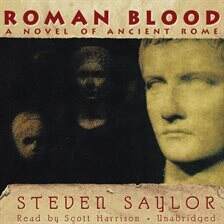 I have written about Saylor’s fictional recounting of the real-life Austin Servant Girl Annihilator. You read that, RIGHT? Saylor is best known for his Roma Sub Rosa mysteries set in…you guessed it, Ancient Rome!
I have written about Saylor’s fictional recounting of the real-life Austin Servant Girl Annihilator. You read that, RIGHT? Saylor is best known for his Roma Sub Rosa mysteries set in…you guessed it, Ancient Rome!
With the Roberts audiobooks fanning the flames; and having read Kurland’s stories: I was ready for more. Saylor was a no brainer.
He has written over a dozen books featuring Gordianus the Finder. Now, he ‘went back’ and wrote a prequel trilogy. I tried to start the first one, The Seven Wonders. Stephen Plunkett was unlistenable. It felt like he was trying to read the entire thing in a monotone. I had to quit.
However, I still wanted to give Saylor a try, so I got the first ‘proper’ Gordianus book, Roman Blood. Scott Harrison was much better as a narrator. I completed it and immediately moved on to Arms of Nemesis.
I like Gordianus. He’s not a public office holder doing official investigations, like Decius Caeceillius Metellus the younger. Gordianus is essentially a private eye. His bartering to get a bigger fee early in book two was amusing. As with most private eyes, he finds himself in peril more than once. And he ruffles important feathers.
I like the authenticity of the Roman world in Saylor’s and Roberts’ books. It really creates a vivid background. And while I love my Hammett and Nebel, the ancient world setting is pretty cool. Roman Blood taker place in 80 AD, in Rome.
I definitely recommend checking out Saylor, and Roberts, if this kind of thing appeals to you.
THE TROJAN WAR: A NEW HISTORY – Barry StraussSo, last week’s post was all about my life-long love of the Trojan War. Which is rooted in the Iliad. I listened to this non-fiction book on the topic, which got me fired up to write last week’s entry. This was a g
I am not really interested in the spate of Trojan War novels (especially the romance ones. Ugh). Though I mentioned last week, being a huge Rex Stout fan, I like The Great Legend. I’ve long intended to read some David Gemmell, and his trilogy of Trojan War novels seems like a no-brainer for that.
But I’m into the original myth, and the study of the war, and the real-life history around it.
Been awhile since I did a non-fiction book. I learned some things. It mixed content from The Iliad, with information related to it. I learned about battering rams (apparently the real ones weren’t like Grond…), sea power, the Greek city-states: just lots of interesting info. And, I always like hearing about Iliad stuff.
This was a good listen, letting me revisit the Trojan War. Sitting and reading this would have been more difficult, for a couple reasons. But the audiobook totally worked.
What I’ve Been Listening To: November, 2024
What I’ve Been Listening To: Sepetember, 2024
What I’ve Been Listening To: August, 2024
What I’ve Been Listening To: July, 2024
What I’ve Been Listening To: September 2022
May I Read You This Book?

Bob Byrne’s ‘A (Black) Gat in the Hand’ made its Black Gate debut in 2018 and has returned every summer since.
His ‘The Public Life of Sherlock Holmes’ column ran every Monday morning at Black Gate from March, 2014 through March, 2017. And he irregularly posts on Rex Stout’s gargantuan detective in ‘Nero Wolfe’s Brownstone.’ He is a member of the Praed Street Irregulars, founded www.SolarPons.com (the only website dedicated to the ‘Sherlock Holmes of Praed Street’).
He organized Black Gate’s award-nominated ‘Discovering Robert E. Howard’ series, as well as the award-winning ‘Hither Came Conan’ series. Which is now part of THE Definitive guide to Conan. He also organized 2023’s ‘Talking Tolkien.’
He has contributed stories to The MX Book of New Sherlock Holmes Stories — Parts III, IV, V, VI, XXI, and XXXIII.
He has written introductions for Steeger Books, and appeared in several magazines, including Black Mask, Sherlock Holmes Mystery Magazine, The Strand Magazine, and Sherlock Magazine.
Alternate Londons, the Future of Lotteries, and Colony Ships: January-February Print Magazines
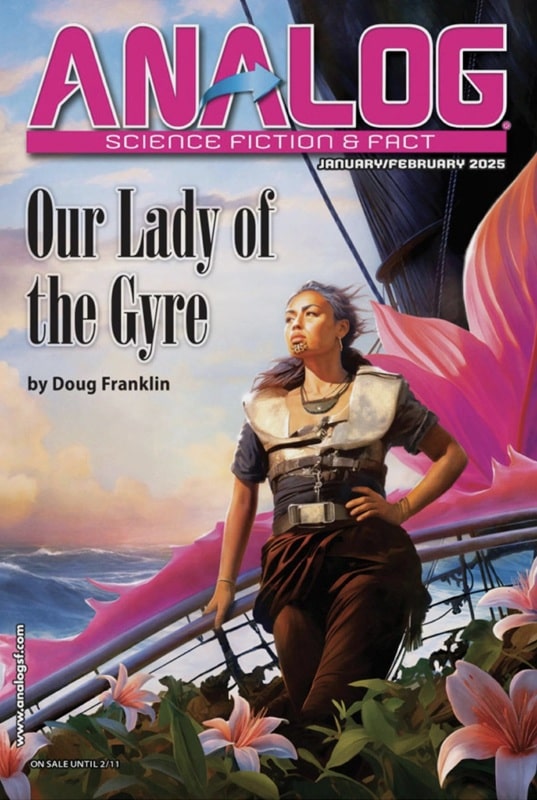

January-February 2025 issues of Analog Science Fiction & Fact and Asimov’s Science
Fiction. Cover art by Tomislav Tikulin (for “Our Lady of the Gyre”) and Shutterstock
Still no sign of the next issue of The Magazine of Fantasy & Science Fiction, which is disheartening. That leaves us with only two issues published last year (Winter 2024 and Summer 2024), and no hint when the next one might arrive. I’m hearing rumors that the magazine has been sold, but I’ve been unable to confirm that, so for now it’s just gossip.
But we’ve got issues of Asimov’s Science Fiction and Analog Science Fiction & Fact in hand, and they’re just as enticing as usual, with contributions from John Shirley, Sean McMullen, Mark W. Teidemann, Steve Rasnic Tem, Paul Di Filippo, Sakinah Hofler, James Van Pelt, James Patrick Kelly, Siobhan Carroll, Robert Reed, Faith Merino, Matthew Kressel, Rick Wilber, Jane Yolen, Kendall Evans, and many more.
The issues contain a new Great Ship tale by Robert Reed, a new Unsettled Worlds story by Siobhan Carroll (which Sam Tomaino calls a “suspenseful, exciting tale”), a new novelette “Rejuve Blues” from John Shirley (which Victoria Silverwolf labels “a suspenseful crime story and psychological study”), and the last installment in James Patrick Kelly’s trio of stories about Marishka Volochkova, “Moon and Mars,” which Sam proclaims is “probably another Nebula nominee.”
Victoria Silverwolf at Tangent Online enjoyed in the latest Analog.
“Our Lady of the Gyre” by Doug Franklin mostly takes place aboard a sea vessel that fights excess carbon dioxide in the atmosphere via bioengineered diatoms. The protagonist, who communicates with an artificial intelligence orbiting the Earth, takes two young people on his ship and faces a dangerous storm… a very dense work of fiction that requires careful reading. At first, it is difficult to tell what’s happening or what this future world is like, but patient readers will be rewarded with a vivid and imaginative tale with appealing characters.
The novelette “Rejuve Blues” by John Shirley features an elderly couple who win a lottery that offers them the chance to be young again. The man runs into trouble with criminals, while the woman, thinking he has left her, returns to her former activity as a fighter against the Taliban. The author creates a complex and convincing future that is neither utopian nor dystopian… a suspenseful crime story and psychological study.
The main character in “Go Your Own Way” by Chris Barnham accidentally discovers a way to travel into alternate versions of London, some very similar to the familiar one and others wildly different. He falls in love in one of these parallel worlds, but the arrival of an alternate version of himself causes complications. The plot is that of the eternal triangle, in which two of the people involved are the same person. (One might call it an isosceles triangle.) The various parallel Londons are described only briefly, and are far more interesting than the love story…
In the novelette “Prince of Spirals” by Sean McMullen, conspirators kidnap a forensic anthropologist and force him to study samples from the skeletons of two bodies thought to be the so-called Princes in the Tower, heirs to King Edward IV of England… The motive is to determine if either Prince survived to have descendants, giving members of the conspiracy a claim to the throne… This is a suspenseful crime story, with intriguing speculative technology and an interesting look at the techniques used by forensic anthropologists.
At first, “Quest of the Sette Comuni” by Paul Di Filippo seems like pure fantasy, as a female satyr and a golem set out to rescue a princess from a wizard, in order to free their master from his imprisonment by a sea-dwelling queen. It soon becomes clear that the golem is actually a machine and the other characters are the result of advanced biotechnology. The setting is richly imagined, from an underwater Venice inhabited by amphibious humans to an antagonist who has made himself resemble the Jabberwock from Lewis Carroll’s famous nonsense poem. Although not a comedy, the story has sufficient amount of subtle wit to draw the reader into its colorful world.
The magazine concludes with the novella “Apartment Wars” by Vera Brook. The setting is Poland in 1979. The widow of a scientist faces the possibility that she will be forced out of her relatively large apartment by the government because she lives alone. She expects her daughter and son-in-law to arrive soon as permanent guests, justifying her need for the place, but time is running out. Meanwhile, the abusive boyfriend of a neighbor threatens to expose her situation to the authorities… The situation takes a dramatic turn when the widow discovers an extraordinary device built by her husband.
Read Victoria’s complete review here.
The new Asimov’s is thoughtfully reviewed by Mina at Tangent Online. Here’s a sample.
“In the Splinterlands the Crows Fly Blind” by Siobhan Carroll takes patience to read. The world building is complex and initially confusing. The protagonist, Charlie, sets off to find his missing brother, Gabe, as well as Gabe’s girlfriend. There are some groovy invented words like Universe-shard, atmotech, Crowmind, Crowdogs and Vestigium — along with words from what seems to be a Cree dialect — they do eventually all make sense. Charlie finds himself a hero as he saves his fragment of world from destruction by the carelessness of “some rich guy stepping on butterflies.” Worth persisting.
“Five Hundred KPH Toward Heaven” by Matthew Kressel is set just after the heyday of lifts into space, reminiscent of train travel. They are being replaced by much faster, cheaper ships. In a final ascent party, Terese reminisces with other lift pilots and ponders on what is being lost — a sense of wonder and a sense of connection — “sometimes there’s benefits to going slow.”
“Shadow of Shadows” by Frank Ward is a pleasure to read because, once you reach the end, the title hits you with its full poignancy. This reader appreciates when an author does this so well. A washed-up research physicist stands at the threshold of finally finding proof for his theory of a “Many Worlds Interpretation.” The proof of alternate universes is, however, not without pain. A tale that explores not just quantum theory but also its emotional repercussions. I would read this twice.
The tension build-up in “What the Frog’s Eye Tells the Frog’s Brain” by Beston Barnett is incredible. One can only say: bravo! In this story, a desperate scientist, being interrogated and tortured by an AI courageously sets out to trick it into shutting down. The references to Linux, Hexspeak and ASCII are very satisfying for this linguist, for AI does indeed have its own language.
“My Biggest Fan” by Faith Merino is a creepy and ultimately sad tale. The narrator grows up seeing the same woman and hearing the same tune at regular intervals; but she is always a different age. She leaves him notes signed “your biggest fan.” When he finally understands why their trajectories keep overlapping, it’s tool late: they have become each other’s hell, as Sartre would say. Quantum particles meet stalker meet Greek tragedy.
In “Moon and Mars” by James Patrick Kelly, Moon-settler Mariska is part of the crew on the Natividad, a colonists’ ship she has joined to be with her Martian boyfriend, Elan. It soon becomes apparent that those with vested interests in the anti-matter that will power the ship through a wormhole to the Destination planet on the other side are trying to stop the mission. Mariska, her mother and Elan are all part of a group determined to take off early before the mission can be stopped. The race against time is gripping…. A great read.
Read Mina’s full review here.
Here’s all the details on the latest SF print mags.
[Click the images for bigger versions.]
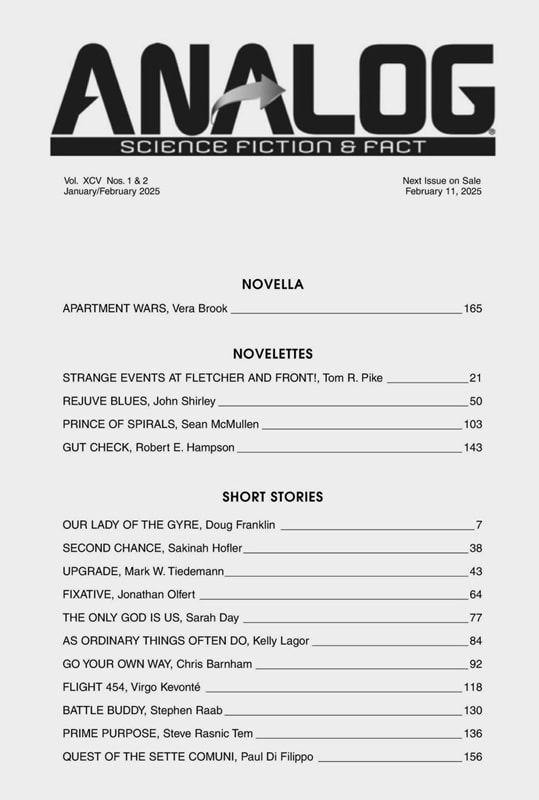

Contents of the January-February 2025 issue of Analog Science Fiction
Editor Trevor Quachri gives us a tantalizing summary of the current issue online, as usual. Sadly, I didn’t think to grab a copy before the latest issues dropped. Next time.
Here’s the full TOC.
Novella
“Apartment Wars” by Vera Brook
Novelettes
“Strange Events at Fletcher and Front!” by Tom R. Pike
“Rejuve Blues” by John Shirley
“Prince of Spirals” by Sean McMullen
“Gut Check” by Robert E. Hampson
Short Stories
“Our Lady of the Gyre” by Doug Franklin
“Second Chance” by Sakinah Hofler
“Upgrade” by Mark W. Teidemann
“Fixative” by Jonathan Olfert
“The Only God is Us” by Sarah Day
“As Ordinary Things Often Do” by Kelly Lagor
“Go Your Own Way” by Chris Barnham
“Flight 454” by Virgo Kevonté
“Battle Buddy” by Stephen Raab
“Prime Purpose” by Steve Rasnic Tem
“Quest of the Sette Comuni” by Paul Di Filippo
Flash Fiction
“Notes From Your Descendants” by Lorraine Alden
“Vigil” by James Van Pelt
“The Spill” by M.T. Reiten
Science Fact
Saving the Skies: How One Small City in Arizona is Pointing the Way to a Better (Darker) Way, by Richard A. Lovett
Poetry
Beyond the Standard Model by Ursula Whitcher
‘Oumuamua by Geoffrey A. Landis
Reader’s Departments
Guest Editorial: Information is Power by John J. Vester
Biolog: Tom R. Pike by Richard A. Lovett
Unknowns, edited by Alec Nevala-Lee:
Hidden Figures by Scott Kim
Robotic Shifting Procedure by Patrick Berry
The Alternate View by John G. Cramer
In Times to Come
The Reference Library by Sean C.W. Korsgaard
Brass Tacks
2024 Index
Upcoming Events by Anthony Lewis
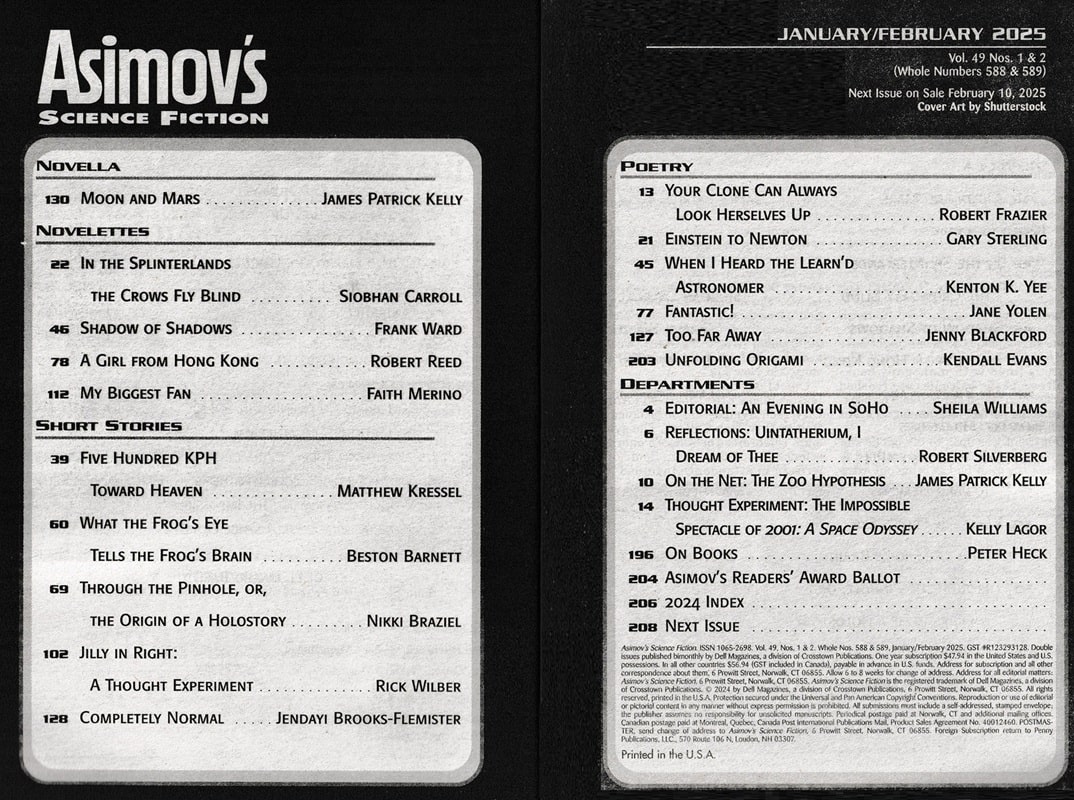 Contents of the January-February 2025 issue of Asimov’s Science Fiction
Asimov’s Science Fiction
Contents of the January-February 2025 issue of Asimov’s Science Fiction
Asimov’s Science Fiction
Sheila Williams provides a handy summary of the latest issue of Asimov’s at the website. But I missed it this month. Next time I’ll remember before it’s gone.
Here’s the complete Table of Contents.
Novella
“Moon and Mars” by James Patrick Kelly
Novelettes
“In the Splinterlands, the Crows Fly Blind” by Siobhan Carroll
“Shadow of Shadows” by Frank Ward
“A Girl from Hong Kong” by Robert Reed
“My Biggest Fan” by Faith Merino
Short Stories
“Five Hundred KPH Toward Heaven” by Matthew Kressel
“What the Frog’s Eye Tells the Frog’s Brain” by Beston Barnett
“Through the Pinhole, Or, the Origin of a Holostory” by Nikki Braziel
“Jilly in Right: A Thought Experiment” by Rick Wilber
“Completely Normal” by Jendayi Brooks-Flemister
Poetry
Your Clone Can Always Look Herselves Up by Robert Frazier
Einstein to Newton by Gary Sterling
When I Heard the Learn’d Astronomer by Kenton K. Yee
Fantastic! by Jane Yolen
Too Far Away by Jenny Blackford
Unfolding Origami by Kendall Evans
Departments
Editorial: An Evening in SoHo by Sheila Williams
Reflections: Uintatherium, I Dream of Thee by Robert Silverberg
On the Net: The Zoo Hypothesis by James Patrick Kelly
Thought Experiment: The Impossible Spectacle of 2001: A Space Odyssey by Kelly Lagor
On Books by Peter Heck
Asimov’s Readers’ Award Ballot
2024 Index
Next Issue
Analog, Asimov’s Science Fiction and The Magazine of Fantasy & Science Fiction are available wherever magazines are sold, and at various online outlets. Buy single issues and subscriptions at the links below.
Asimov’s Science Fiction (208 pages, $8.99 per issue, one year sub $47.97 in the US) — edited by Sheila Williams
Analog Science Fiction and Fact (208 pages, $8.99 per issue, one year sub $47.97 in the US) — edited by Trevor Quachri
The Magazine of Fantasy & Science Fiction (256 pages, $10.99 per issue, one year sub $65.94 in the US) — edited by Sheree Renée Thomas
The January-February issues of Asimov’s and Analog were on sale until February 11. See our coverage of the November-December issues here, and all our recent magazine coverage here.


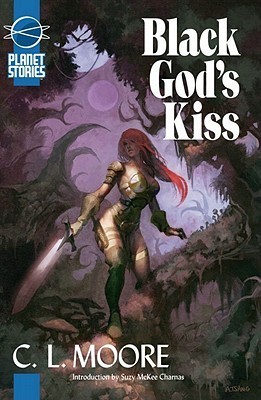
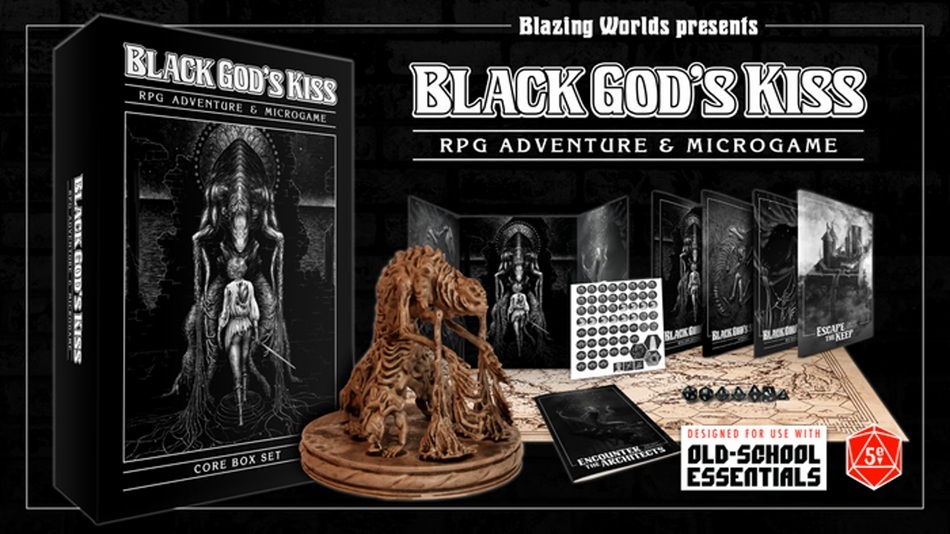



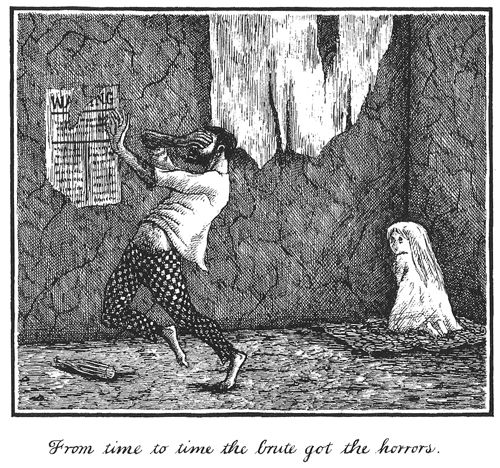
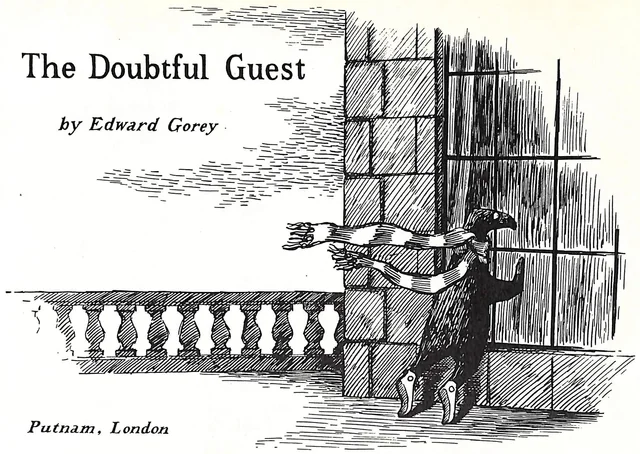


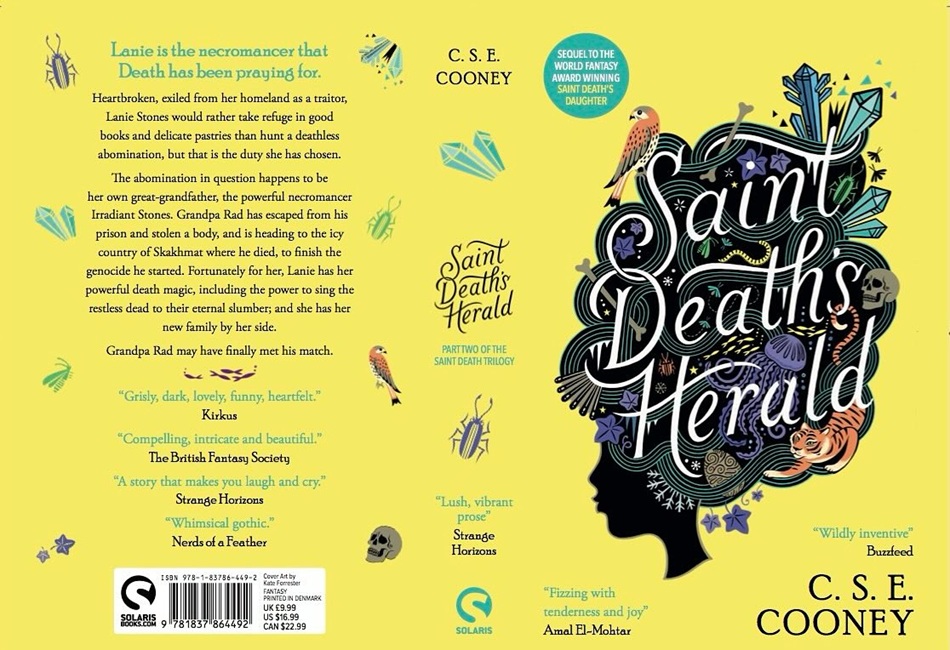
Recent comments